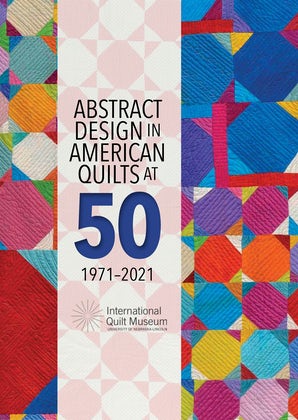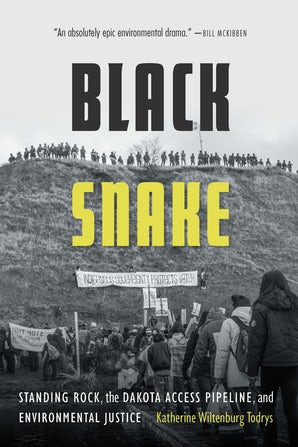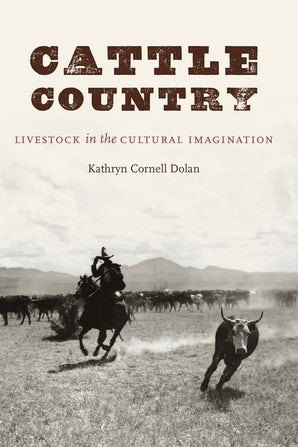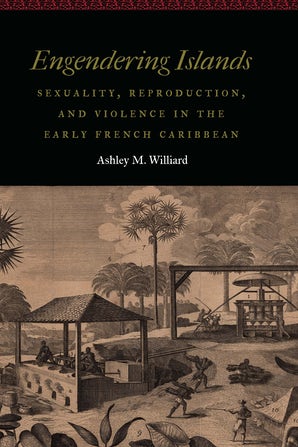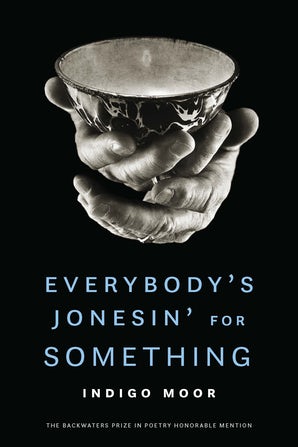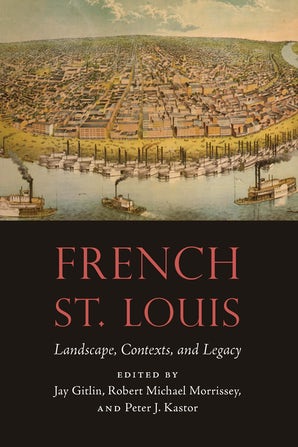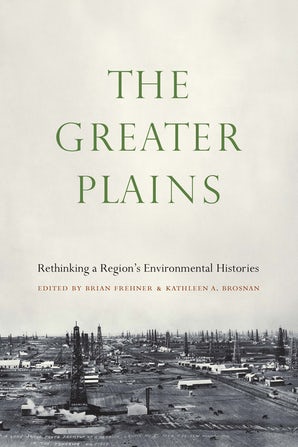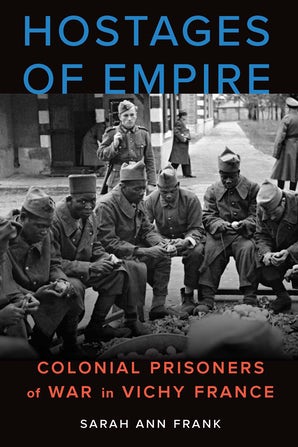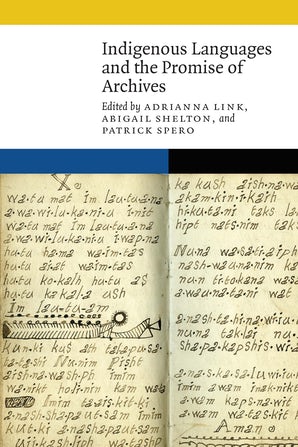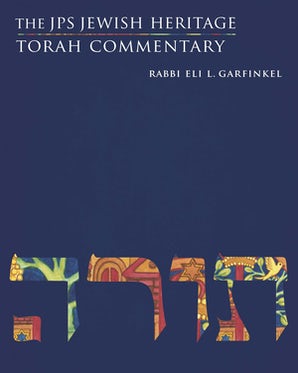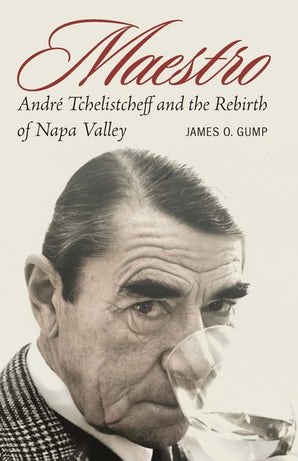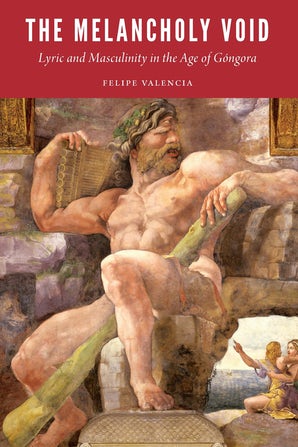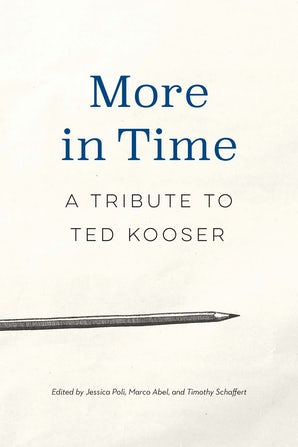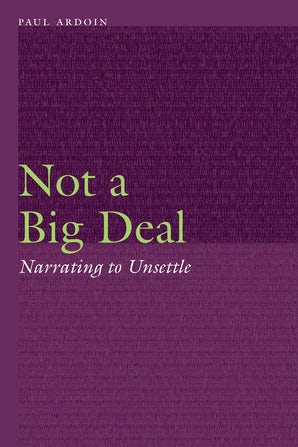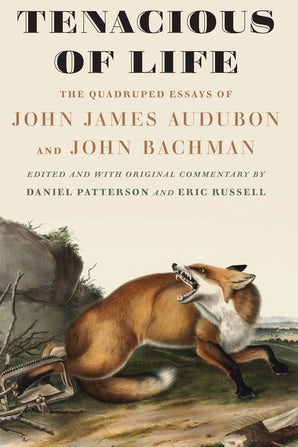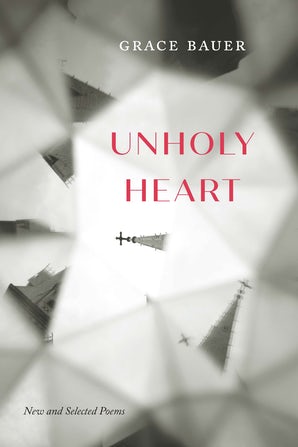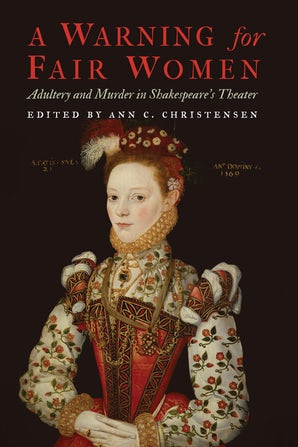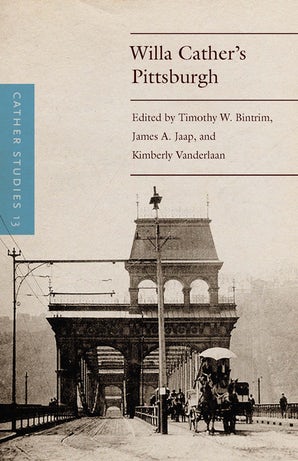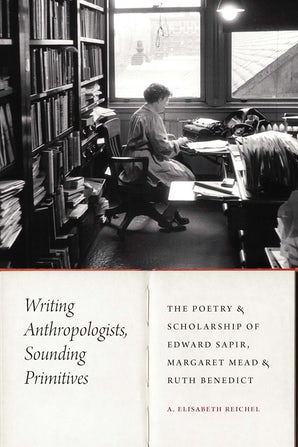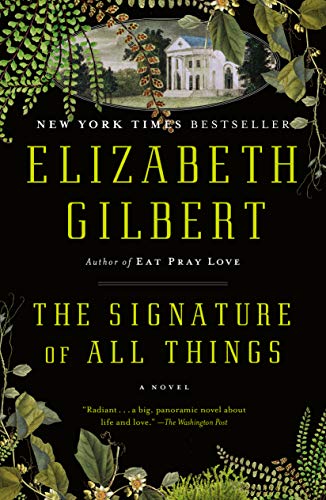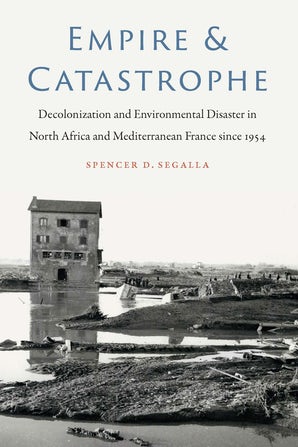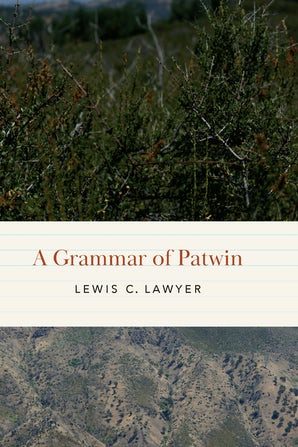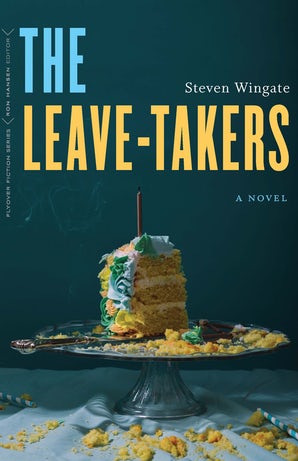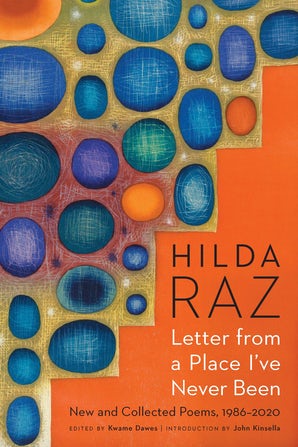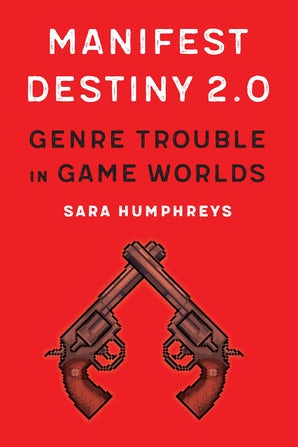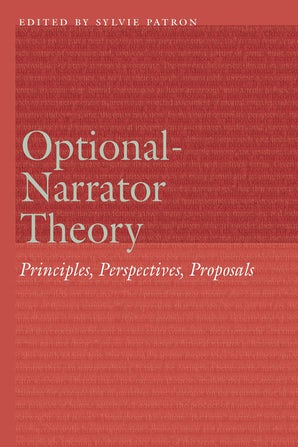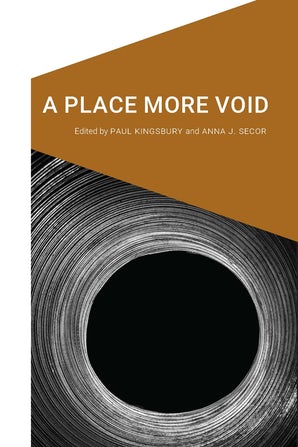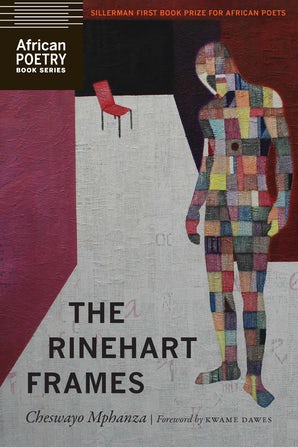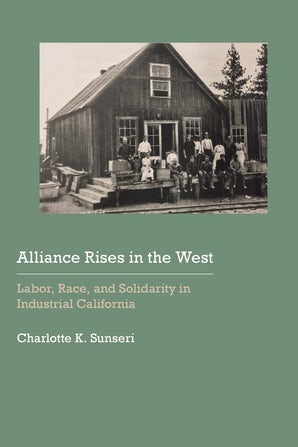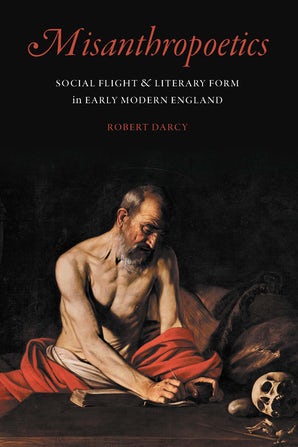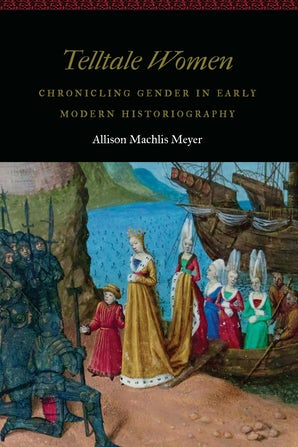Search the Blog
Categories
- Books & Reading
- Broadband Buzz
- Census
- Education & Training
- Friday Reads
- General
- Grants
- Information Resources
- Library Management
- Nebraska Center for the Book
- Nebraska Libraries on the Web
- Nebraska Memories
- Now hiring @ your library
- Preservation
- Pretty Sweet Tech
- Programming
- Public Library Boards of Trustees
- Public Relations
- Talking Book & Braille Service (TBBS)
- Technology
- Uncategorized
- What's Up Doc / Govdocs
- Youth Services
Archives
Subscribe
Author Archives: Mary Sauers
Book Briefs: New University of Nebraska Press Books at the Nebraska Publications Clearinghouse
The Nebraska Publications Clearinghouse receives documents every month from all Nebraska state agencies, including the University of Nebraska Press (UNP). Each month we will be showcasing the UNP books that the Clearinghouse receives. UNP books, as well as all Nebraska state documents, are available for checkout by libraries and librarians for their patrons.
Here are the University of Nebraska Press books received in May and June 2021:
Abstract Design in American Quilts at 50 : 1971-2021
Edited by Marin F. Hanson ; Contributing authors: Jonathan Holstein, Carolyn Ducey, Sandra Sider, Jonathan Gregory, Nao Nomura, and Marin F. Hanson
Fifty years after its debut, the exhibition Abstract Design in American Quilts is remembered as a pivotal moment in the intersecting histories of art, craft, and design. Installed at New York’s Whitney Museum of American Art in 1971, the exhibition presented traditional American pieced quilts on walls more commonly used to display modern art such as abstract expressionist paintings. The exhibition, curated by Jonathan Holstein and Gail van der Hoof from their own collection, unexpectedly struck a chord with museumgoers and art critics alike, breaking attendance records and subsequently traveling to museums across the United States, Europe, and Japan.
With Abstract Design in American Quilts at 50, an exhibition series that includes an installation of the original quilt group, the International Quilt Museum at the University of Nebraska–Lincoln reexamines the half-century impact of this watershed exhibition. In five essays, leading quilt scholars assess the areas upon which the exhibition, in its various iterations, had its greatest impact, most notably the growth of quiltmaking across the United States and in art circles. The essays also discuss broader cultural phenomena that produced an environment in which quilts and other forms of material culture could be viewed and valued in new ways.
Black Snake : Standing Rock, the Dakota Access Pipeline, and Environmental Justice
By Katherine Wiltenburg Todrys
The controversial Dakota Access Pipeline (DAPL) made headlines around the world in 2016. Supporters called the pipeline key to safely transporting American oil from the Bakken oil fields of the northern plains to markets nationwide, essential to both national security and prosperity. Native activists named it the “black snake,” referring to an ancient prophecy about a terrible snake that would one day devour the earth. Activists rallied near the Standing Rock Reservation in North Dakota for months in opposition to DAPL, winning an unprecedented but temporary victory before the federal government ultimately permitted the pipeline. Oil began flowing on June 1, 2017.
The water protector camps drew global support and united more than three hundred tribes in perhaps the largest Native alliance in U.S. history. While it faced violent opposition, the peaceful movement against DAPL has become one of the most crucial human rights movements of our time.
Black Snake is the story of four leaders—LaDonna Allard, Jasilyn Charger, Lisa DeVille, and Kandi White—and their fight against the pipeline. It is the story of Native nations combating environmental injustice and longtime discrimination and rebuilding their communities. It is the story of a new generation of environmental activists, galvanized at Standing Rock, becoming the protectors of America’s natural resources.
California & Hawai’i Bound : U.S. Settler Colonialism and the Pacific West, 1848-1959
By Henry Knight Lozano ; Series: Studies in Pacific Worlds
Beginning in the era of Manifest Destiny, U.S. settlers, writers, politicians, and boosters worked to bind California and Hawai‘i together in the American imagination, emphasizing white settlement and capitalist enterprise. In California and Hawai‘i Bound Henry Knight Lozano explores how these settlers and boosters promoted and imagined California and Hawai‘i as connected places and sites for U.S. settler colonialism, and how this relationship reveals the fraught constructions of an Americanized Pacific West from the 1840s to the 1950s.
The growing ties of promotion and development between the two places also fostered the promotion of “perils” over this transpacific relationship, from Native Hawaiians who opposed U.S. settler colonialism to many West Coast Americans who articulated social and racial dangers from closer bonds with Hawai‘i, illustrating how U.S. promotional expansionism in the Pacific existed alongside defensive peril in the complicated visions of Americanization that linked California and Hawai‘i.
California and Hawai‘i Bound demonstrates how the settler colonial discourses of Americanization that connected California and Hawai‘i evolved and refracted alongside socioeconomic developments and native resistance, during a time when U.S. territorial expansion, transoceanic settlement and tourism, and capitalist investment reconstructed both the American West and the eastern Pacific.
Cattle Country : Livestock in the Cultural Imagination
By Kathryn Cornell Dolan ; Series: At Table
As beef and cattle production progressed in nineteenth-century America, the cow emerged as the nation’s representative food animal and earned a culturally prominent role in the literature of the day. In Cattle Country Kathryn Cornell Dolan examines the role cattle played in narratives throughout the century to show how the struggles within U.S. food culture mapped onto society’s broader struggles with colonization, environmentalism, U.S. identity, ethnicity, and industrialization.
Dolan examines diverse texts from Native American, African American, Mexican American, and white authors that showcase the zeitgeist of anxiety surrounding U.S. identity as cattle gradually became an industrialized food source, altering the country’s culture while exacting a high cost to humans, animals, and the land. From Henry David Thoreau’s descriptions of indigenous cuisines as a challenge to the rising monoculture, to Washington Irving’s travel narratives that foreshadow cattle replacing American bison in the West, to María Amparo Ruiz de Burton’s use of cattle to connect race and imperialism in her work, authors’ preoccupations with cattle underscored their concern for resource depletion, habitat destruction, and the wasteful overproduction of a single breed of livestock.
Cattle Country offers a window into the ways authors worked to negotiate the consequences of the development of this food culture and, by excavating the history of U.S. settler colonialism through the figure of cattle, sheds new ecocritical light on nineteenth-century literature.
Engendering Islands : Sexuality, Reproduction, and Violence in the Early French Caribbean
By Ashley M. Williard ; Series: Women and Gender in the Early Modern World
In seventeenth-century Antilles the violence of dispossession and enslavement was mapped onto men’s and women’s bodies, bolstered by resignified tropes of gender, repurposed concepts of disability, and emerging racial discourses. As colonials and ecclesiastics developed local practices and institutions—particularly family formation and military force—they consolidated old notions into new categories that affected all social groups.
In Engendering Islands Ashley M. Williard argues that early Caribbean reconstructions of masculinity and femininity sustained occupation, slavery, and nascent ideas of race. In the face of historical silences, Williard’s close readings of archival and narrative texts reveals the words, images, and perspectives that reflected and produced new ideas of human difference. Juridical, religious, and medical discourses expose the interdependence of multiple conditions—male and female, enslaved and free, Black and white, Indigenous and displaced, normative and disabled—in the islands claimed for the French Crown.
In recent years scholars have interrogated key aspects of Atlantic slavery, but none have systematically approached the archive of gender, particularly as it intersects with race and disability, in the seventeenth-century French Caribbean. The constructions of masculinity and femininity embedded in this early colonial context help elucidate attendant notions of otherness and the systems of oppression they sustained. Williard shows the ways gender contributed to and complicated emerging notions of racial difference that justified slavery and colonial domination, thus setting the stage for centuries of French imperialism.
Everybody’s Jonesin’ For Something
By Indigo Moor ; Series: The Backwaters Prize in Poetry Honorable Mention
Turning an unflinching spotlight on the American Dream, Indigo Moor plunges headfirst into national—and personal—laments and desires. From Emmett Till to the fall of the Twin Towers and through the wildfires of Paradise, California, Moor weaves a thread through the hopes, sacrifices, and Sisyphean yearnings that make this country the beautiful trap that it is. Everybody’s Jonesin’ for Something takes an imagistic leap through the darker side of our search for life, liberty, and the pursuit of happiness, perusing what we lose, what we leave behind, and what strange beauty we uncover.
French St. Louis : Landscape, Contexts, and Legacy
Edited by Jay Gitlin, Robert Michael Morrissey, and Peter J. Kastor ; Series: France Overseas: Studies in Empire and Decolonization
A gateway to the West and an outpost for eastern capital and culture, St. Louis straddled not only geographical and political divides but also cultural, racial, and sectional ones. At the same time, it connected a vast region as a gathering place of peoples, cultures, and goods. The essays in this collection contextualize St. Louis, exploring French-Native relations, the agency of empire in the Illinois Country, the role of women in “mapping” the French colonial world, fashion and identity, and commodities and exchange in St. Louis as part of a broader politics of consumption in colonial America. The collection also provides a comparative perspective on America’s two great Creole cities, St. Louis and New Orleans. Lastly, it looks at the Frenchness of St. Louis in the nineteenth century and the present.
French St. Louis recasts the history of St. Louis and reimagines regional development in the early American republic, shedding light on its francophone history.
The Greater Plains : Rethinking a Region’s Environmental Histories
Edited by Brian Frehner & Kathleen A Brosnan
The Greater Plains tells a new story of a region, stretching from the state of Texas to the province of Alberta, where the environments are as varied as the myriad ways people have inhabited them. These innovative essays document a complicated history of human interactions with a sometimes plentiful and sometimes foreboding landscape, from the Native Americans who first shaped the prairies with fire to twentieth-century oil regimes whose pipelines linked the region to the world.
The Greater Plains moves beyond the narrative of ecological desperation that too often defines the region in scholarly works and in popular imagination. Using the lenses of grasses, animals, water, and energy, the contributors reveal tales of human adaptation through technologies ranging from the travois to bookkeeping systems and hybrid wheat. Transnational in its focus and interdisciplinary in its scholarship, The Greater Plains brings together leading historians, geographers, anthropologists, and archaeologists to chronicle a past rich with paradoxical successes and failures, conflicts and cooperation, but also continual adaptation to the challenging and ever-shifting environmental conditions of the North American heartland.
Hostages of Empire : Colonial Prisoners of War in Vichy France
By Sarah Ann Frank ; Series: France Overseas: Studies in Empire and Decolonization
Hostages of Empire combines a social history of colonial prisoner-of-war experiences with a broader analysis of their role in Vichy’s political tensions with the country’s German occupiers. The colonial prisoners of war came from across the French Empire, they fought in the Battle for France in 1940, and they were captured by the German Army. Unlike their French counterparts, who were taken to Germany, the colonial POWs were interned in camps called Frontstalags throughout occupied France. This decision to keep colonial POWs in France defined not only their experience of captivity but also how the French and German authorities reacted to them.
Hostages of Empire examines how the entanglement of French national pride after the 1940 defeat and the need for increased imperial control shaped the experiences of 85,000 soldiers in German captivity. Sarah Ann Frank analyzes the nature of Vichy’s imperial commitments and collaboration with its German occupiers and argues that the Vichy regime actively improved conditions of captivity for colonial prisoners in an attempt to secure their present and future loyalty. This French “magnanimity” toward the colonial prisoners was part of a broader framework of racial difference and hierarchy. As such, the relatively dignified treatment of colonial prisoners must be viewed as a paradox in light of Vichy and Free French racism in the colonies and the Vichy regime’s complicity in the Holocaust. Hostages of Empire seeks to reconcile two previously rather distinct histories: that of metropolitan France and that of the French colonies during World War II.
Indian Soldiers in World War I : Race and Representation in an Imperial War
By Andrew T. Jarboe ; Series: Studies in War, Society, and the Military
More than one million Indian soldiers were deployed during World War I, serving in the Indian Army as part of Britain’s imperial war effort. These men fought in France and Belgium, Egypt and East Africa, and Gallipoli, Palestine, and Mesopotamia.
In Indian Soldiers in World War I Andrew T. Jarboe follows these Indian soldiers—or sepoys—across the battlefields, examining the contested representations British and Indian audiences drew from the soldiers’ wartime experiences and the impacts these representations had on the British Empire’s racial politics. Presenting overlooked or forgotten connections, Jarboe argues that Indian soldiers’ presence on battlefields across three continents contributed decisively to the British Empire’s final victory in the war. While the war and Indian soldiers’ involvement led to a hardening of the British Empire’s prewar racist ideologies and governing policies, the battlefield contributions of Indian soldiers fueled Indian national aspirations and calls for racial equality. When Indian soldiers participated in the brutal suppression of anti-government demonstrations in India at war’s end, they set the stage for the eventual end of British rule in South Asia.
Indigenous Languages and the Promise of Archives
Edited by Adrianna Link, Abigail Shelton, and Patrick Spero ; Series: New Visions in Native American and Indigenous Studies
Indigenous Languages and the Promise of Archives captures the energy and optimism that many feel about the future of community-based scholarship, which involves the collaboration of archives, scholars, and Native American communities. The American Philosophical Society is exploring new applications of materials in its library to partner on collaborative projects that assist the cultural and linguistic revitalization movements within Native communities. A paradigm shift is driving researchers to reckon with questionable practices used by scholars and libraries in the past to pursue documents relating to Native Americans, practices that are often embedded in the content of the collections themselves.
The Center for Native American and Indigenous Research at the American Philosophical Society brought together this volume of historical and contemporary case studies highlighting the importance of archival materials for the revitalization of Indigenous languages. Essays written by archivists, historians, anthropologists, knowledge-keepers, and museum professionals, cover topics critical to language revitalization work; they tackle long-standing debates about ownership, access, and control of Indigenous materials stored in repositories; and they suggest strategies for how to decolonize collections in the service of community-based priorities. Together these essays reveal the power of collaboration for breathing new life into historical documents.
The JPS Jewish Heritage Torah Commentary
By Rabbi Eli L. Garfinkel ; Series: JPS Study Bible
The JPS Jewish Heritage Torah Commentary shows Jews of all ages and backgrounds that the Jewish people’s most significant book is not dusty and irrelevant but an eternally sacred text wholly pertinent to our modern lives. Designed to keep the attention of all readers, each lively essay is both brief enough to be read in minutes and deep and substantive enough to deliver abundant food for thought.
Its cornerstone is its unique four-part meditation on the Jewish heritage. After briefly summarizing a Torah portion, the commentary orbits that portion through four central pillars of Jewish life—the Torah (Torat Yisrael), the land of Israel (Eretz Yisrael), the Jewish people (Am Yisrael), and Jewish thought (Mahshevet Yisrael)—illuminating how the four intersect and enrich one another. Furthering the Jewish thought motif, every essay ends with two questions for thought well suited for discussion settings. Each commentary can be used as the launchpad for a lesson, a sermon, a d’var Torah, or a discussion.
Readers from beginners to experts will come away with new understandings of our Jewish heritage—and be inspired to draw closer to its four dimensions.
Maestro : André Tchelistcheff and the Rebirth of Napa Valley
By James O. Gump ; Series: At Table
Wine insiders called André Tchelistcheff the “winemaker’s winemaker,” the “wine doctor,” and simply “maestro.” After Prohibition brought Napa Valley and its wine industry to the brink of catastrophe, Tchelistcheff (1901–94) proved essential in its revitalization.
Tchelistcheff’s unique background—a sickly child, a Russian émigré forced from his homeland during the Bolshevik Revolution, a White Army lieutenant who fought in the Crimea, a physical laborer in a Bulgarian coal mine, a Czechoslovakian-trained agronomist, and a French-schooled viticulturist and enologist—prepared him for a remarkable winemaking career. He spent thirty-five years in Napa Valley’s Beaulieu Vineyard and nearly two “post-retirement” decades doing freelance consulting work for more than thirty wineries.
His early struggles forged his principal character traits, which he passed on to an entire generation of winemakers. His students, including some of the most accomplished winemakers of the post-Prohibition period, marveled over their mentor’s sense of authority, profound insight, humble presence, and abundant wisdom.
This inspiring account of Tchelistcheff’s life includes interviews with friends, family, and mentees, which reveal how one man used his passion and knowledge to help save a community on the edge of disaster. In Maestro James O. Gump preserves the memory of a fascinating individual and one of the most influential winemakers of the modern era.
The Melancholy Void : Lyric and Masculinity in the Age of Góngora
By Felipe Valencia ; Series: New Hispanisms
At the turn of the seventeenth century, Spanish lyric underwent a notable development. Several Spanish poets reinvented lyric as a melancholy and masculinist discourse that sang of and perpetrated symbolic violence against the female beloved. This shift emerged in response to the rising prestige and commercial success of the epic and was enabled by the rich discourse on the link between melancholy and creativity in men.
In The Melancholy Void Felipe Valencia examines this reconstruction of the lyric in key texts of Spanish poetry from 1580 to 1620. Through a study of canonical and influential texts, such as the major poems by Luis de Góngora and the epic of Alonso de Ercilla, but also lesser-known texts, such as the lyrics by Miguel de Cervantes, The Melancholy Void addresses four understudied problems in the scholarship of early modern Spanish poetry: the use of gender violence in love poetry as a way to construct the masculinity of the poetic speaker; the exploration in Spanish poetry of the link between melancholy and male creativity; the impact of epic on Spanish lyric; and the Spanish contribution to the fledgling theory of the lyric.
The Melancholy Void brings poetry and lyric theory to the conversation in full force and develops a distinct argument about the integral role of gender violence in a prominent strand of early modern Spanish lyric that ran from Garcilaso to Góngora and beyond.
More in Time : A Tribute to Ted Kooser
Edited by Jessica Poli, Marco Abel, and Timothy Schaffert
More in Time is a celebration and tribute to Ted Kooser, two-time U.S. Poet Laureate, winner of the Pulitzer Prize for Poetry, and Presidential Professor of the University of Nebraska. Through personal reflections, essays, and creative works both inspired by and dedicated to Kooser, this collection shines a light on the many ways the midwestern poet has affected others as a teacher, mentor, colleague, and friend, as well as a fellow writer and observer-of-the-world. The creative responses included in this volume are reflective of the impact Kooser has had in his connections to other writers, while also revealing glimpses of his distinct way of seeing.
The New White Race : Settler Colonialism and the Press in French Algeria, 1860-1914
By Charlotte Ann Legg ; Series: France Overseas: Studies in Empire and Decolonization
The New White Race traces the development of the press in Algeria between 1860 and 1914, examining the particular role of journalists in shaping the power dynamics of settler colonialism. Constrained in different ways by the limitations imposed on free expression in a colonial context, diverse groups of European settlers, Algerian Muslims, and Algerian Jews nevertheless turned to the press to articulate their hopes and fears for the future of the land they inhabited and to imagine forms of community which would continue to influence political debates until the Algerian War. The frontiers of these imagined communities did not necessarily correlate with those of the nation—either French or Algerian—but framed processes of identification that were at once local, national, and transnational.
The New White Race explores these processes of cultural and political identification, highlighting the production practices, professional networks, and strategic-linguistic choices mobilized by journalists as they sought to influence the sentiments of their readers and the decisions of the French state. Announcing the creation of a “new white race” among the mixed European population of Algeria, settler journalists hoped to increase the autonomy of the settler colony without forgoing the protections afforded by their French rulers. Their ambivalent expressions of “French” belonging, however, reflected tensions among the colonizers; these tensions were ably exploited by those who sought to transform or contest French imperial rule.
Not a Big Deal : Narrating to Unsettle
By Paul Ardoin ; Series: Frontiers of Narrative
Not a Big Deal asks how texts might work to unsettle readers at a moment when unwelcome information is rejected as fake news or rebutted with alternative facts. When readers already recognize “defamiliarizing texts” as a category, how might texts still work toward the goals of defamiliarization? When readers refuse to grapple with texts that might shock them or disrupt their extant views about politics, race, or even narrative itself, how can texts elicit real engagement?
This study draws from philosophy, narratology, social neuroscience, critical theory, and numerous other disciplines to read texts ranging from novels and short stories to graphic novels, films, and fiction broadcasted and podcasted—all of which enact curious strategies of disruption while insisting that they do no such thing.
Following a model traceable to Toni Morrison’s criticism and short fiction, texts by Kyle Baker, Scott Brown, Percival Everett, Daniel Handler, David Robert Mitchell, Jordan Peele, and Colson Whitehead suggest new strategies for unsettling the category-based perceptions behind what Everett calls “the insidious colonialist reader’s eye which infects America.” Not a Big Deal examines problems in our perception of the world and of texts and insists we do the same.
On the Sidelines : Gendered Neoliberalism and the American Female Sportscaster
By Guy Harrison ; Series: Sports, Media, and Society
When sports fans turn on the television or radio today, they undoubtedly find more women on the air than ever before. Nevertheless, women sportscasters are still subjected to gendered and racialized mistreatment in the workplace and online and are largely confined to anchor and sideline reporter positions in coverage of high-profile men’s sports. In On the Sidelines Guy Harrison weaves in-depth interviews with women sportscasters, focus groups with sports fans, and a collection of media products to argue that gendered neoliberalism—a cluster of exclusionary twenty-first-century feminisms—maintains this status quo.
Spinning a cohesive narrative, Harrison shows how sportscasting’s dependence on gendered neoliberalism broadly places the onus on women for their own success despite systemic sexism and racism. As a result, women in the industry are left to their own devices to navigate double standards, bias in hiring and development for certain on-air positions, harassment, and emotional labor. Through the lens of gendered neoliberalism, On the Sidelines examines each of these challenges and analyzes how they have been reshaped and maintained to construct a narrow portrait of the ideal neoliberal female sportscaster. Consequently, these challenges are taken for granted as “natural,” sustaining women’s marginalization in the sportscasting industry.
Pseudo-Memoirs : Life and Its Imitation in Modern Fiction
By Rochelle Tobias ; Series: Frontiers of Narrative
Pseudo-Memoirs redefines the notion of fiction itself, a form that has all too often been understood in terms of its capacity to produce a seeming reality. Rochelle Tobias argues that the verisimilitude of the novel derives not from its object but from the subjectivity at its base. What generates the plausibility of fiction is not the referentiality of its depictions but the intentionality of consciousness.
Edmund Husserl developed the idea that consciousness is always intentional in the sense that it is directed outside itself toward something that it does not find so much as it constitutes as an object. Pseudo-memoirs reveal the full implications of this position in their double structure as the tale of their own telling or the fiction of life-writing. In so doing they reveal how the world of fiction is constructed, but more important they bring to the fore the idealist premises that fuel the novel and guarantee its truth, even when it remains an invention of the imagination.
Rochelle Tobias explores novels by Thomas Mann, Robert Walser, Thomas Bernhard, and W. G. Sebald in conjunction with philosophical and theoretical texts by René Descartes, Husserl, Friedrich Nietzsche, György Łukács, Roland Barthes, and Maurice Blanchot.
Tenacious of Life : The Quadruped Essays of John James Audubon and John Bachman
By John James Audubon and John Bachman, Edited and with original commentary by Daniel Patterson and Eric Russell
Daniel Patterson and Eric Russell present a groundbreaking case for considering John James Audubon’s and John Bachman’s quadruped essays as worthy of literary analysis and redefine the role of Bachman, the perpetually overlooked coauthor of the essays. After completing The Birds of America (1826–38), Audubon began developing his work on the mammals. The Viviparous Quadrupeds of North America volumes show an antebellum view of nature as fundamentally dynamic and simultaneously grotesque and awe-inspiring. The quadruped essays are rich with good stories about these mammals and the humans who observe, pursue, and admire them.
For help with the science and the essays, Audubon enlisted the Reverend John Bachman of Charleston, South Carolina. While he has been acknowledged as coauthor of the essays, Bachman has received little attention as an American nature writer. While almost all works that describe the history of American nature writing include Audubon, Bachman shows up only in a subordinate clause or two. Tenacious of Life strives to restore Bachman’s status as an important American nature writer.
Patterson and Russell analyze the coauthorial dance between the voices of Audubon, an experienced naturalist telling adventurous hunting stories tinged often by sentiment, romanticism, and bombast, and of Bachman, the courteous gentleman naturalist, scientific detective, moralist, sometimes cruel experimenter, and humorist. Drawing on all the primary and secondary evidence, Patterson and Russell tell the story of the coauthors’ fascinating, conflicted relationship. This collection offers windows onto the early United States and much forgotten lore, often in the form of travel writing, natural history, and unique anecdotes, all told in the compelling voices of Antebellum America’s two leading naturalists.
Thinking About Good and Evil : Jewish Views from Antiquity to Modernity
By Rabbi Wayne Allen ; Series: JPS Essential Judaism
The most comprehensive book on the topic, Thinking about Good and Evil traces the most salient Jewish ideas about why innocent people seem to suffer, why evil individuals seem to prosper, and God’s role in such matters of (in)justice, from antiquity to the present.
Starting with the Bible and Apocrypha, Rabbi Wayne Allen takes us through the Talmud; medieval Jewish philosophers and Jewish mystical sources; the Ba’al Shem Tov and his disciples; early modern thinkers such as Spinoza, Mendelssohn, and Luzzatto; and, finally, modern thinkers such as Cohen, Buber, Kaplan, and Plaskow. Each chapter analyzes individual thinkers’ arguments and synthesizes their collective ideas on the nature of good and evil and questions of justice. Allen also exposes vastly divergent Jewish thinking about the Holocaust: traditionalist (e.g., Ehrenreich), revisionist (e.g., Rubenstein, Jonas), and deflective (e.g., Soloveitchik, Wiesel).
Rabbi Allen’s engaging, accessible volume illuminates well-known, obscure, and novel Jewish solutions to the problem of good and evil.
Transmovimientos : Latinx Queer Migrations, Bodies, and Spaces
Edited by Ellie D. Hernández, Eddy Francisco Alvarez Jr., and Magda García
Within a trans-embodied framework, this anthology identifies transmovimientos as the creative force or social mechanism through which queer, trans, and gender nonconforming Latinx communities navigate their location and calibrate their consciousness. This anthology unveils a critical perspective with the emphasis on queer, trans, and gender nonconforming communities of immigrants and social dissidents who reflect on and write about diaspora and migratory movements while navigating geographical and embodied spaces across gendered and racialized contexts, all crucial elements of the trans-movements taking place in the United States.
This collection forms a nuanced conversation between scholarship and social activism that speaks in concrete ways about diasporic and migratory LGBTQ communities who suffer from immoral immigration policies and political discourses that produce untenable living situations. The focal point of analysis throughout Transmovimientos examines migratory movements and anti-immigrant sentiment, homophobia, and stigma toward people who are transgender, immigrants, and refugees. These deliberate consciousness-based expressions are designed to realign awareness about the body in transit and the diasporic experience of relocating and emerging into new possibilities.
Unholy Heart : New and Selected Poems
By Grace Bauer
Unholy Heart includes generous selections from each of Grace Bauer’s previous books of poetry, plus a sampling of new poems. Bauer has long been known for the wide range of both her subject matter and poetic styles, from the biblical persona poems of The Women at the Well, to the explorations of visual art in Beholding Eye, to the intersections of personal history and pop culture in Retreats and Recognitions and Nowhere All At Once, and to the postmodern fragmentations in MEAN/TIME. Along with these selections, Bauer incorporates her most elegiac work yet.
A Warning for Fair Women : Adultery and Murder in Shakespeare’s Theater
Edited by Ann C. Christensen ; Series: Early Modern Cultural Studies
A Warning for Fair Women is a 1599 true-crime drama from the repertory of Shakespeare’s acting company. While important to literary scholars and theater historians, it is also readable, relevant, and stage-worthy today. Dramatizing the murder of London merchant George Saunders by his wife’s lover, and the trials and executions of the murderer and accomplices, it also sheds light on neighborhood and domestic life and crime and punishment.
This edition of A Warning for Fair Women is fully updated, featuring a lively and extensive introduction and covering topics from authorship and staging to the 2018 world revival of the play in the United States. It includes a section with discussion and research questions along with resources on topics raised by the play, from beauty and women’s friendship to the occult. Ann C. Christensen presents a freshly edited text for today’s readers, with in-depth explanatory notes, scene summaries, a gallery of period images, and full scholarly apparatus.
Willa Cather’s Pittsburgh
Edited by Timothy W. Bintrim, James A. Jaap, and Kimberly Vanderlaan ; Series: Volume 13, Cather Studies
Willa Cather wrote about the places she knew, including Nebraska, New Mexico, New York, and Virginia. Often forgotten among these essential locations has been Pittsburgh. During the ten years Pittsburgh was her home (1896–1906), Cather worked as an editor, journalist, teacher, and freelance writer. She mixed with all sorts of people and formed friendships both ephemeral and lasting. She published extensively—and not just profiles and reviews but also a collection of poetry, April Twilights, and more than thirty short stories, including several collected in The Troll Garden that are now considered masterpieces: “A Death in the Desert,” “The Sculptor’s Funeral,” “A Wagner Matinee,” and “Paul’s Case.” During extended working vacations through 1916, she finished four novels in Pittsburgh.
Writing Anthropologists, Sounding Primitives : The Poetry & Scholarship of Edward Sapir, Margaret Mead & Ruth Benedict
By A. Elisabeth Reichel : Critical Studies in the History of Anthropology
Writing Anthropologists, Sounding Primitives re-examines the poetry and scholarship of three of the foremost figures in the twentieth-century history of U.S.-American anthropology: Edward Sapir, Margaret Mead, and Ruth Benedict. While they are widely renowned for their contributions to Franz Boas’s early twentieth-century school of cultural relativism, what is far less known is their shared interest in probing the representational potential of different media and forms of writing. This dimension of their work is manifest in Sapir’s critical writing on music and literature and Mead’s groundbreaking work with photography and film. Sapir, Mead, and Benedict together also wrote more than one thousand poems, which in turn negotiate their own media status and rivalry with other forms of representation.
A. Elisabeth Reichel presents the first sustained study of the published and unpublished poetry of Sapir, Mead, and Benedict, charting this largely unexplored body of work and relevant selections of the writers’ scholarship. In addition to its expansion of early twentieth-century literary canons, Writing Anthropologists, Sounding Primitives contributes to current debates about the relations between different media, sign systems, and modes of sense perception in literature and other media. Reichel offers a unique contribution to the history of anthropology by synthesizing and applying insights from the history of writing, sound studies, and intermediality studies to poetry and scholarship produced by noted early twentieth-century U.S.-American cultural anthropologists.
Friday Reads: The Signature of All Things
The Signature of All Things, by Elizabeth Gilbert.
I love reading historical novels, especially ones that are based in fact and teach me about a subject I previously knew little about. The Signature of All Things is just such a book. Elizabeth Gilbert’s descriptions of the botanical world, and how plants were discovered, acquired, and improved, are truly masterful.
Spanning much of the eighteenth and nineteenth centuries, this novel follows the fortunes of the extraordinary Whittaker family, led by the enterprising Henry Whittaker—a poor-born Englishman who makes a great fortune in the South American quinine trade, eventually becoming the richest man in Philadelphia. Born in 1800, Henry’s brilliant daughter, Alma (who inherits both her father’s money and his mind), ultimately becomes a botanist of considerable gifts herself. As Alma’s research takes her deeper into the mysteries of evolution, she falls in love with a man named Ambrose Pike who makes incomparable paintings of orchids and who draws her in the exact opposite direction—into the realm of the spiritual, the divine, and the magical. Alma is a clear-minded scientist; Ambrose a utopian artist—but what unites this unlikely couple is a desperate need to understand the workings of this world and the mechanisms behind all life.
Exquisitely researched and told at a galloping pace, The Signature of All Things soars across the globe—from London to Peru to Philadelphia to Tahiti to Amsterdam, and beyond. Along the way, the story is peopled with unforgettable characters: missionaries, abolitionists, adventurers, astronomers, sea captains, geniuses, and the quite mad. But most memorable of all, it is the story of Alma Whittaker, who—born in the Age of Enlightenment, but living well into the Industrial Revolution—bears witness to that extraordinary moment in human history when all the old assumptions about science, religion, commerce, and class were exploding into dangerous new ideas. (Amazon.com)
Book Briefs: New University of Nebraska Press Books at the Nebraska Publications Clearinghouse
The Nebraska Publications Clearinghouse receives documents every month from all Nebraska state agencies, including the University of Nebraska Press (UNP). Each month we will be showcasing the UNP books that the Clearinghouse receives. UNP books, as well as all Nebraska state documents, are available for checkout by libraries and librarians for their patrons.
Here are the UNP books the Clearinghouse received in March and April 2021:
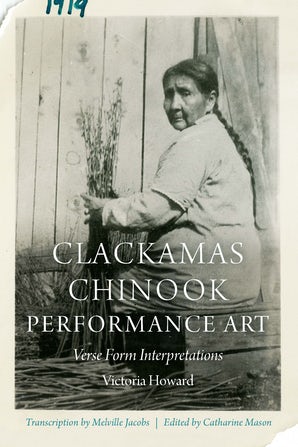
Clackamas Chinook Performance Art : Verse Form Interpretations by Victoria Howard ; (Series: Studies in the Anthropology of North American Indians)
Published through the Recovering Languages and Literacies of the Americas initiative, supported by the Andrew W. Mellon Foundation
Victoria Howard was born around 1865, a little more than ten years after the founding of the Confederated Tribes of Grand Ronde in western Oregon. Howardʼs maternal grandmother, Wagayuhlen Quiaquaty, was a successful and valued Clackamas shaman at Grand Ronde, and her maternal grandfather, Quiaquaty, was an elite Molalla chief. In the summer of 1929 the linguist Melville Jacobs, student of Franz Boas, requested to record Clackamas Chinook oral traditions with Howard, which she enthusiastically agreed to do. The result is an intricate and lively corpus of linguistic and ethnographic material, as well as rich performances of Clackamas literary heritage, as dictated by Howard and meticulously transcribed by Jacobs in his field notebooks. Ethnographical descriptions attest to the traditional lifestyle and environment in which Howard grew up, while fine details of cultural and historical events reveal the great consideration and devotion with which she recalled her past and that of her people.
Catharine Mason has edited twenty-five of Howard’s spoken-word performances into verse form entextualizations, along with the annotations provided by Jacobs in his publications of Howard’s corpus in the late 1950s. Mason pairs performances with biographical, family, and historical content that reflects Howardʼs ancestry, personal and social life, education, and worldview. Mason’s study reveals strong evidence of how the artist contemplated and internalized the complex meanings and everyday lessons of her literary heritage.
Empire and Catastrophe : Decolonization and Environmental Disaster in North Africa and Mediterranean France since 1954 by Spencer D. Segalla ; (Series: France Overseas: Studies in Empire and Decolonization)
Empire and Catastrophe examines natural and anthropogenic disasters during the years of decolonization in Algeria, Morocco, and France and explores how environmental catastrophes both shaped and were shaped by struggles over the dissolution of France’s empire in North Africa. Four disasters make up the core of the book: the 1954 earthquake in Algeria’s Chélif Valley, just weeks before the onset of the Algerian Revolution; a mass poisoning in Morocco in 1959 caused by toxic substances from an American military base; the 1959 Malpasset Dam collapse in Fréjus, France, which devastated the town’s Algerian immigrant community but which was blamed on Algerian sabotage; and the 1960 earthquake in Agadir, Morocco, which set off a public relations war between the United States, France, and the Soviet Union and which ignited a Moroccan national debate over modernity, identity, architecture, and urban planning.
Interrogating distinctions between agent and environment and between political and environmental violence through the lenses of state archives and through the remembered experiences and literary representations of disaster survivors, Spencer D. Segalla argues for the integration of environmental events into narratives of political and cultural decolonization.
A Grammar of Patwin by Lewis C. Lawyer ; (Series: Studies in the Native Languages of the Americas)
Published through the Recovering Languages and Literacies of the Americas initiative, supported by the Andrew W. Mellon Foundation.
A Native American language formerly spoken in hundreds of communities in the interior of California, Patwin (also known as Wintun Tʼewe) is now spoken by a small but growing number of language revitalizationists and their students. A Grammar of Patwin brings together two hundred years of word lists, notebooks, audio recordings, and manuscripts from archives across the United States and synthesizes this scattered collection into the first published description of the Patwin language. This book shines a light on the knowledge of past speakers and researchers with a clear and well-organized description supported by ample archival evidence.
Lewis C. Lawyer addresses the full range of grammatical structure with chapters on phonetics, phonology, nominals, nominal modifiers, spatial terms, verbs, and clauses. At every level of grammatical structure there is notable variation between dialects, and this variation is painstakingly described. An introductory chapter situates the language geographically and historically and also gives a detailed account of previous work on the language and of the archival materials on which the study is based. Throughout the process of writing this book, Lawyer remained in contact with Patwin communities and individuals, who helped to ensure that the content is appropriate from a cultural perspective.
The Leave-Takers : A Novel by Steven Wingate ; (Series: Flyover Fiction)
Four years ago Jacob Nassedrine from Boston and Laynie Jackman from Los Angeles came within an inch of getting married before things blew apart. They never expected that fate would hurl them back together in a windblown, isolated house on the plains of South Dakota, but that’s where they end up fighting for the future of their relationship—and for their own emotional survival—amid a minefield of ghosts.
After suffering the loss of both their families, they must unite to face the great crises of their lives: grief and guilt over their dead loved ones, low-level but persistent addictions to prescription drugs, the specter of familial violence, and recurrent miscarriages. Together they battle their way through the wilderness of their demons to forge sustainable identities that allow them to create a family.
The Leave-Takers is a journey through personal darkness to mutually shared light, set against a starkly beautiful backdrop that leaves nowhere to hide.
Letter from a Place I’ve Never Been : New and Collected Poems, 1986-2020 by Hilda Raz
Hilda Raz has an ability “to tell something every day and make it tough,” says John Kinsella in his introduction. Letter from a Place I’ve Never Been shows readers the evolution of a powerful poet who is also one of the foremost literary editors in the country. Bringing together all seven of her poetry collections, a long out-of-print early chapbook, and her newest work, this collection delights readers with its empathetic and incisive look at the inner and outer lives we lead and the complexities that come with being human.
Showcasing the work of a great American voice, Letter from a Place I’ve Never Been at last allows us to see the full scope and range of Raz’s work.
Manifest Destiny 2.0 : Genre Trouble in Game Worlds by Sara Humphreys ; (Series: Postwestern Horizons)
At a time when print and film have shown the classic Western and noir genres to be racist, heteronormative, and neocolonial, Sara Humphreys’s Manifest Destiny 2.0 asks why these genres endure so prolifically in the video game market. While video games provide a radically new and exciting medium for storytelling, most game narratives do not offer fresh ways of understanding the world.
Video games with complex storylines are based on enduring American literary genres that disseminate problematic ideologies, quelling cultural anxieties over economic, racial, and gender inequality through the institutional acceptance and performance of Anglo cultural, racial, and economic superiority. Although game critics and scholars recognize how genres structure games and gameplay, the concept of genre continues to be viewed as a largely invisible power, subordinate to the computational processes of programming, graphics, and the making of a multimillion-dollar best seller.
Investigating the social and cultural implications of the Western and noir genres in video games through two case studies—the best-selling games Red Dead Redemption (2010) and L.A. Noire (2011)—Humphreys demonstrates how the frontier myth continues to circulate exceptionalist versions of the United States. Video games spread the neoliberal and neocolonial ideologies of the genres even as they create a new form of performative literacy that intensifies the genres well beyond their originating historical contexts. Manifest Destiny 2.0 joins the growing body of scholarship dedicated to the historical, theoretical, critical, and cultural analysis of video games.
Optional-Narrator Theory : Principles, Perspectives, Proposals Edited by Sylvie Patron ; (Series: Frontiers of Narrative)
Twentieth-century narratology fostered the assumption, which distinguishes narratology from previous narrative theories, that all narratives have a narrator. Since the first formulations of this assumption, however, voices have come forward to denounce oversimplifications and dangerous confusions of issues. Optional-Narrator Theory is the first collection of essays to focus exclusively on the narrator from the perspective of optional-narrator theories.
Sylvie Patron is a prominent advocate of optional-narrator theories, and her collection boasts essays by many prominent scholars—including Jonathan Culler and John Brenkman—and covers a breadth of genres, from biblical narrative to poetry to comics. This volume bolsters the dialogue among optional-narrator and pan-narrator theorists across multiple fields of research. These essays make a strong intervention in narratology, pushing back against the widespread belief among narrative theorists in general and theorists of the novel in particular that the presence of a fictional narrator is a defining feature of fictional narratives. This topic is an important one for narrative theory and thus also for literary practice.
Optional-Narrator Theory advances a range of arguments for dispensing with the narrator, except when it can be said that the author actually “created” a fictional narrator.
A Place More Void Edited by Paul Kingsbury and Anna J. Secor ; (Series: Cultural Geographies + Rewriting the Earth)
A Place More Void takes its name from a scene in William Shakespeare’s The Tragedy of Julius Caesar, wherein an elderly soothsayer has a final chance to warn Caesar about the Ides of March. Worried that he won’t be able to deliver his message because of the crowded alleyways, the soothsayer devises a plan to find and intercept Caesar in “a place more void.” It is precisely such an elusive place that this volume makes space for by theorizing and empirically exploring the many yet widely neglected ways in which the void permeates geographical thinking.
This collection presents geography’s most in-depth and sustained engagements with the void to date, demonstrating the extent to which related themes such as gaps, cracks, lacks, and emptiness perforate geography’s fundamental concepts, practices, and passions. Arranged in four parts around the themes of Holes, Absences, Edges, and Voids, the contributions demonstrate the fecundity of the void for thinking across a wide range of phenomena: from archives to alien abductions, caves to cryptids, and vortexes to vanishing points.
A Place More Void gathers established and emerging scholars who engage a wide range of geographical issues and who express themselves not only through archival, literary, and socio-scientific investigations, but also through social and spatial theory, political manifesto, poetry, and performance art.
The Rinehart Frames by Cheswayo Mphanza ; (Series: African Poetry Book)
The poems in The Rinehart Frames seek to exhaust the labyrinths of ekphrasis. By juxtaposing the character of Rinehart from Ralph Ellison’s Invisible Man with the film 24 Frames by Abbas Kiarostami, the poems leap into secondary histories, spaces, and languages that encompass a collective yet varied consciousness of being.
Cheswayo Mphanza’s collection questions the boundaries of diaspora and narrative through a tethering of voices and forms that infringe on monolithic categorizations of Blackness and what can be intersected with it. The poems continue the conversations of the infinite possibilities of the imagination to dabble in, with, and out of history.
Your Crib, My Qibla by Saddiq Dzukogi ; (Series: African Poetry Book)
Your Crib, My Qibla interrogates loss, the death of a child, and a father’s pursuit of language able to articulate grief. In these poems, the language of memory functions as a space of mourning, connecting the dead with the world of the living. Culminating in an imagined dialogue between the father and his deceased daughter in the intricate space of the family, Your Crib, My Qibla explores grief, the fleeting nature of healing, and the constant obsession of memory as a language to reach the dead.
**All synopses courtesy of University of Nebraska Press (https://www.nebraskapress.unl.edu/)
COVID-19 Special Enrollment Period Extended to August 15
Extended Access Opportunity to Enroll in More Affordable Coverage Through HealthCare.gov
Mar 23, 2021
Under the American Rescue Plan, many people who buy their own health insurance directly through the Marketplace will become eligible to receive increased tax credits to reduce their premiums. Starting April 1, 2021, consumers enrolling in Marketplace coverage through HealthCare.gov will be able to take advantage of these increased savings and lower costs.
Building on the success of the current 2021 special enrollment period in response to the COVID-19 Public Health Emergency, and acknowledging that the COVID-19 public health emergency (PHE) continues to constitute exceptional circumstances that are sufficient to qualify individuals for an exceptional circumstances SEP, CMS will extend access to a 30-day SEP on HealthCare.gov until August 15, 2021. This action will allow individuals and families more time to access the SEP and enroll in Marketplace coverage with the increased tax credits to reduce their premiums, and for current enrollees to change plans in response to the availability of increased tax credits if they wish to do so.
Additionally, beginning in early July on HealthCare.gov, consumers who have received or have been determined eligible to receive unemployment compensation for any week during 2021 may be able to get another increase in savings when enrolling in new Marketplace coverage or updating their existing Marketplace application and enrollment. These savings to be made available starting in early July for eligible consumers are in addition to the increased savings available to consumers on HealthCare.gov starting April 1.
You can also find out additional information on the American Rescue Plan and special enrollment period by accessing our previously issued and updated resources. Consumers served by State-based Marketplaces that do not use the HealthCare.gov platform can check their state’s website to find out more information on the American Rescue Plan implementation and special enrollment periods in their state.
- American Rescue Plan — For more information and FAQs on the American Rescue Plan, please see the fact sheet and FAQs here: https://www.cms.gov/newsroom/fact-sheets/american-rescue-plan-and-marketplace
- Updated! 2021 Special Enrollment Period for COVID-19 Public Health Emergency Technical Stakeholder Guidance — The guidance document describes the SEP and provides answers to frequently asked questions. You can access the updated guidance at: https://www.cms.gov/CCIIO/Resources/Regulations-and-Guidance/2021-SEP-guidance.pdf
Special Enrollment Period and other Eligibility and Enrollment Questions
- Will CMS extend the time period during which consumers can access a 30-day special enrollment period (SEP) to allow more consumers to newly enroll in coverage to take advantage of the subsidy provisions in the American Rescue Plan, or change to a new plan based on their new subsidy amount?
- Yes, CMS will extend the time period during which consumers can access a 30 day SEP to newly enroll in Marketplace coverage or change to a new Marketplace plan through the 2021 special enrollment based on their eligibility for increased financial assistance to help pay for Marketplace coverage. CMS will extend the period of time during which consumers can access the 2021 special enrollment period until August 15, 2021 for consumers who apply through the HealthCare.gov platform.
- What exactly do current enrollees need to do to receive the increased tax credit amount?
- Current enrollees should submit an application update on or after April first to receive an updated eligibility determination. To do so, consumers should use the “report a life change” pathway to update their application, and then click the option for “change to my household’s income,” even if all the information on the application remains the same. After submitting the application update and receiving a new eligibility determination, consumers should enter the “plan compare” section of the site and confirm their current plan selection, so that their insurance company receives their new tax credit information.
- If desired, consumers may instead choose to make a new plan selection, but should consider how much they have already paid toward the deductible when deciding whether or not a change in plan makes sense. When a consumer changes plans, the amount they’ve already paid towards meeting their prior plan’s deductible and annual limit on cost sharing may be reset to zero, and they would need to start over paying out of pocket expenses to meet their new deductible and to reach the annual limit on cost sharing on their new plan. If they have made significant payments toward their current plan’s annual limit on cost sharing, consumers should check with their insurance company to see how it might impact them and what options are available to keep credit toward what they have already paid.
- How will consumers be notified of their updated eligibility for increased financial assistance?
- Once they update or submit a new application, consumers will receive an eligibility determination notice that they can download. Depending on their expressed preferences, they may also receive a hard copy mailed to their address. This notice will include consumers’ updated financial assistance amount and instructions for what they need to do next, such as select a plan and submit documentation to confirm their income or immigration status if necessary.
- For consumers who update their applications in April, when will the increased premium tax credits take effect?
- Updates to APTC generally take effect with the next month’s premium bill. As a result, updated plan selections made on or before April 30 will result in APTC increases effective May 1, updated plan selections made on or before May 31 will result in APTC increases effective June 1, and so on.
- How soon will consumers’ bills include a reduced premium that takes into account the increased premium tax credits?
- Updates to advance payments of the premium tax credit (APTC) generally take effect with the next month’s premium bill. As a result, updated plan selections made on or after April 1 and on or before April 30 will result in APTC increases effective May 1, and thus will be reflected on May bills.
- Will consumers be able to increase their APTC to make up for receiving too little for earlier months of the year (given that both increases are effective January 1, 2021 according to the American Rescue Plan Act), or will they need to wait and collect those additional amounts on their tax return?
- We do not anticipate applying PTC amounts for the months of January-April to future-month bills in the form of APTC, due to the significant complexity required for implementation of this retroactive application. Consumers will be able to claim this benefit in the form of PTC at the time of federal income tax filing when reconciling their premium tax credits for the entire year.
- Does the new law change anything about how the affordability of employer-based coverage is determined?
- No, employer-based coverage is still considered affordable for an employee and for any dependents to whom an offer extends if the amount the employee would pay for the lowest-cost plan that meets the minimum value standard and covers only the employee does not exceed a certain percentage of the employee’s household income. This is true even if the employee and other members of the household want to enroll in a plan that costs more and/or that covers dependents.
What’s Up Doc? New State Agency Publications at the Nebraska Library Commission
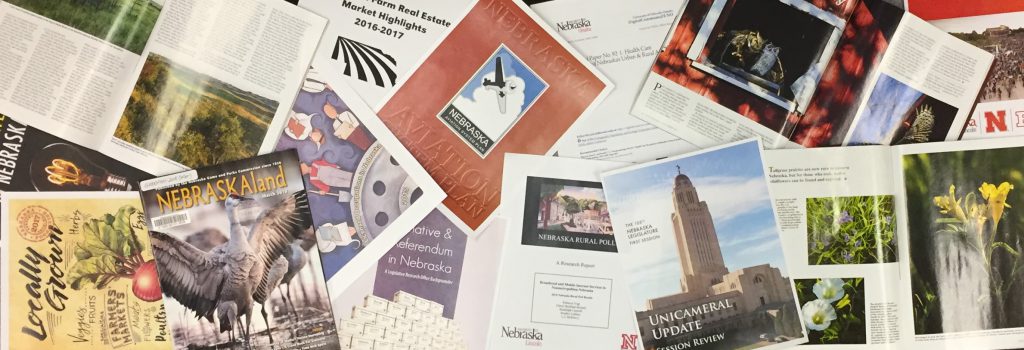
New state agency publications have been received at the Nebraska Library Commission for January and February 2021. Included are reports from the Nebraska Auditor of Public Accounts, the Nebraska Department of Economic Development, the Nebraska Legislature, the Nebraska Department of Transportation, and new books from the University of Nebraska Press, to name a few.
Most items, except the books from the University of Nebraska Press, are available for immediate viewing and printing by clicking on the highlighted link above, or directly in the .pdf below. You can read synopses of the books received from the University of Nebraska Press in the Book Briefs blogposts.
The Nebraska Legislature created the Nebraska Publications Clearinghouse in 1972, a service of the Nebraska Library Commission. Its purpose is to collect, preserve, and provide access to all public information published by Nebraska state agencies. By law (State Statutes 51-411 to 51-413) all Nebraska state agencies are required to submit their published documents to the Clearinghouse. For more information, visit the Nebraska Publications Clearinghouse page, contact Mary Sauers, Government Information Services Librarian; or contact Bonnie Henzel, State Documents Staff Assistant.
Book Briefs: New University of Nebraska Press Books at the Nebraska Publications Clearinghouse
The Nebraska Publications Clearinghouse receives documents every month from all Nebraska state agencies, including the University of Nebraska Press (UNP). Each month we will be showcasing the UNP books that the Clearinghouse receives. UNP books, as well as all Nebraska state documents, are available for checkout by libraries and librarians for their patrons.
Here are the UNP books the Clearinghouse received in January and February 2021:
Alliance Rises in the West : Labor, Race, and Solidarity in Industrial California by Charlotte K. Sunseri. (Series: Historical Archaeology of the American West)
Alliance Rises in the West documents the experiences of a company town at a critical moment in the rise of working-class consciousness in nineteenth-century California. Through archaeological research Charlotte K. Sunseri overcomes the silence of the documentary record to re-examine the mining frontier at Mono Mills, a community of multiple ethnic and racial groups, predominantly Chinese immigrants and Kudzadika Paiutes. The rise of political, economic, and social alliances among workers symbolized solidarity and provided opportunity to effect change in this setting of unequal power. Urban planning and neighborhood layout depict company structures of control and surveillance, while household archaeology from ethnically distinct neighborhoods speaks to lived experiences and how working-class identities emerged to crosscut ethnic and racial divides imposed in capitalism.
Mono Mills’s Paiute and Chinese communities experienced exclusionary legislation and brutal treatment on the basis of racial prejudice but lived alongside and built community with European American laborers, managers, and merchants who were also on an economic periphery. These experiences in Mono Mills and other nineteenth-century company towns did not occur in a vacuum; capitalists’ control and ideologies of race and class all doubled down as American workers used collective action to change the rules of the system. In this rare, in-depth perspective, close consideration of the ghost towns that dot the landscape of the West shows the haunting elements of capitalism and racial structures that characterized Gilded Age society and whose legacies endure to this day.
Hybrid Anxieties : Queering the French-Algerian War and Its Postcolonial Legacies by C. L. Quinan.(Series: Expanding Frontiers: Interdisciplinary Approaches to Studies of Women, Gender, and Sexuality)
Situated at the crossroads of queer theory and postcolonial studies, Hybrid Anxieties analyzes the intertwined and composite aspects of identities and textual forms in the wake of the French-Algerian War (1954–1962). C. L. Quinan argues that the war precipitated a dynamic in which a contestation of hegemonic masculinity occurred alongside a production of queer modes of subjectivity, embodiment, and memory that subvert norms. Innovations in literature and cinema were also directly impacted by the long and difficult process of decolonization, as the war provoked a rethinking of politics and aesthetics. The novels, films, and poetry analyzed in Hybrid Anxieties trace this imbrication of content and form, demonstrating how a postwar fracturing had both salutary and injurious effects, not only on bodies and psyches but also on artistic forms.
Adopting a queer postcolonial perspective, Hybrid Anxieties adds a new impulse to the question of how to rethink hegemonic notions of gender, sexuality, and nationality, thereby opening up new spaces for considering the redemptive and productive possibilities of negotiating life in a postcolonial context. Without losing sight of the trauma of this particularly violent chapter in history, Hybrid Anxieties proposes a new kind of hybridity that, however anxious and anticipatory, emphasizes the productive forces of a queer desire to deconstruct teleological relationships between past, present, and future.
Misanthropoetics : Social Flight and Literary Form in Early Modern England by Robert Darcy.
Misanthropoetics explores efforts by Renaissance writers to represent social flight and withdrawal as a fictional escape from the incongruous demands of culture. Through the invented term of its title, this book investigates the literary misanthrope in a number of key examples from Shakespeare, Jonson, Spenser, and the satirical milieu of Marston to exemplify the seemingly unresolvable paradoxes of social life.
In Shakespeare’s England a burgeoning urban population and the codification of social controls drove a new imaginary of revolt and flight in the figure of the literary misanthrope. This figure of disillusionment became an experiment in protesting absurd social demands, pitting friendship and family against prudent economies, testimonies of durable love against erosions of historical time, and stable categories of gender against the breakdown and promiscuity of language.
Misanthropoetics chronicles the period’s own excoriating critique of the illusion of resolution fostered within a social world beleaguered by myriad pressures and demands. This study interrogates form as a means not toward order but toward the impasse of irresolution, to detecting and declaring the social function of life as inherently incongruous. Robert Darcy applies questions of phenomenology and psychoanalysis, deconstruction and chaos theory to observe how the great deployers of literary form lost confidence that it could adhere to clear and stable rules of engagement, even as they tried desperately to shape and preserve it.
Telltale Women : Chronicling Gender in Early Modern Historiography by Allison Machlis Meyer. (Series: Women and Gender in the Early Modern World)
Telltale Women fundamentally reimagines the relationship between the history play and its source material as an intertextual one, presenting evidence for a new narrative about how—and why—these genres disparately chronicle the histories of royal women. Allison Machlis Meyer challenges established perceptions of source study, historiography, and the staging of gender politics in well-known drama by arguing that chronicles and political histories frequently value women’s political interventions and use narrative techniques to invest their voices with authority. Dramatists who used these sources for their history plays thus encountered a historical record that offered surprisingly ample precedents for depicting women’s perspectives and political influence as legitimate, and writers for the commercial theater grappled with such precedents by reshaping source material to create stage representations of royal women that condemned queenship and female power.
By tracing how the sanctioning of women’s political participation changes from the narrative page to the dramatic stage, Meyer demonstrates that gender politics in both canonical and noncanonical history plays emerge from playwrights’ intertextual engagements with a rich alternative view of women in the narrative historiography of the sixteenth and seventeenth centuries.
Book Briefs: New University of Nebraska Press Books at the Nebraska Publications Clearinghouse

The Nebraska Publications Clearinghouse receives documents every month from all Nebraska state agencies, including the University of Nebraska Press (UNP). Each month we will be showcasing the UNP books that the Clearinghouse receives. UNP books, as well as all Nebraska state documents, are available for checkout by libraries and librarians for their patrons.
Here are the UNP books the Clearinghouse received in November and December 2020:
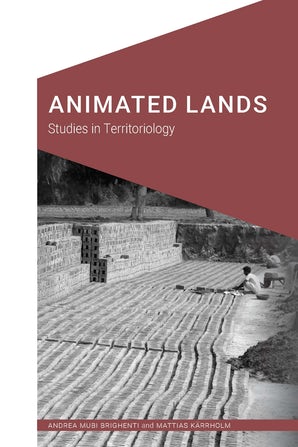
Animated Lands : Studies in Territoriology by Andrea Mubi Brighenti and Mattias Karrholm (Series: Cultural Geographies ; Rewriting the Earth)
In Animated Lands Andrea Mubi Brighenti and Mattias Kärrholm focus on territory as a living phenomenon—and territoriality as an active and constantly reshaping force. They explore the complexity of territorial production through a series of parallel investigations into fundamental territorial themes, such as rhythm, synchronization, melody, morphogenesis, and animism.
The notion of territory is excavated through case studies including the analysis of urban playgrounds, homemaking, the transformations of urban walls, and the stabilization of peculiar building types such as the house-museum. These empirical examples span such cities as Ahmedabad, Amsterdam, London, and Rome. Animated Lands provides a broad introduction to what a theory of territories could be and how it could help to advance sociospatial studies.
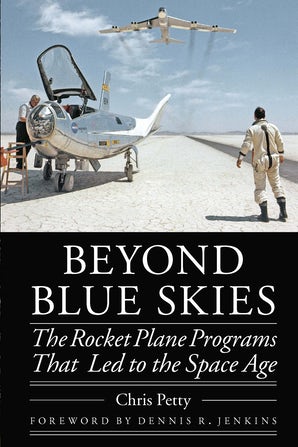
Beyond Blue Skies : The Rocket Plant Programs That Led to the Space Age by Chris Petty (Series: Outward Odyssey:A People’s History of Spaceflight)
In 1945 some experts still considered the so-called sound barrier an impenetrable wall, while winged rocket planes remained largely relegated to science fiction. But soon a series of unique rocket-powered research aircraft and the dedicated individuals who built, maintained, and flew them began to push the boundaries of flight in aviation’s quest to move ever higher, ever faster, toward the unknown. Beyond Blue Skies examines the thirty-year period after World War II during which aviation experienced an unprecedented era of progress that led the United States to the boundaries of outer space.
Between 1946 and 1975, an ancient dry lakebed in California’s High Desert played host to a series of rocket-powered research aircraft built to investigate the outer reaches of flight. The western Mojave’s Rogers Dry Lake became home to Edwards Air Force Base, NASA’s Flight Research Center, and an elite cadre of test pilots. Although one of them—Chuck Yeager—would rank among the most famous names in history, most who flew there during those years played their parts away from public view. The risks they routinely accepted were every bit as real as those facing NASA’s astronauts, but no magazine stories or free Corvettes awaited them—just long days in a close-knit community in the High Desert.
The role of not only the test pilots but the engineers, aerodynamicists, and support staff in making supersonic flight possible has been widely overlooked. Beyond Blue Skies charts the triumphs and tragedies of the rocket-plane era and the unsung efforts of the men and women who made amazing achievements possible.
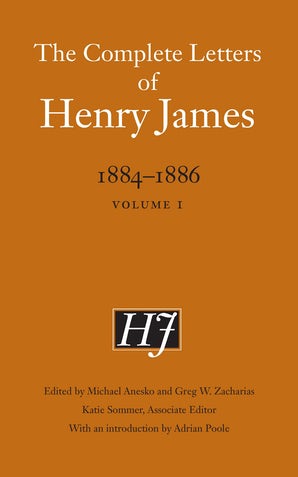
The Complete Letters of Henry James, 1884-1886, Volume I Edited by Michael Anesko and Greg W. Zacharias (Series: The Complete Letters of Henry James)Recipient of the Approved Edition seal from the Modern Language Association’s Committee on Scholarly Editions
This volume of The Complete Letters of Henry James, 1884–1886 includes 179 letters, 94 published for the first time, written between November 11, 1884, and December 21, 1885. The letters mark Henry James’s ongoing efforts to care for his sister, develop his work, strengthen his professional status, build friendships old and new, and maximize his income. James details work on midcareer novels The Bostonians and The Princess Casamassima as well as on tales that would help to define his career. He reveals his close acquaintance with British politics and politicians. This volume opens with Alice James’s arrival in England and concludes with Henry James’s plans to leave his flat in Piccadilly for his new address in De Vere Gardens, Kensington.
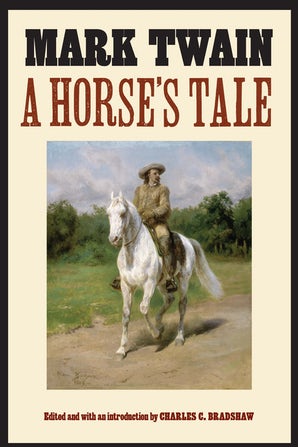
A Horse’s Tale by Mark Twain ; Edited and with an introduction by Charles C. Bradshaw. (Series: The Papers of William F. “Buffalo Bill” Cody)
At the turn of the twentieth century Minnie Maddern Fiske, a New York actress, socialite, and animal rights activist, wrote to Mark Twain with an unusual request: for Twain to write about the evils of bullfighting equal to that of his anti-vivisectionist story A Dog’s Tale. Twain responded with A Horse’s Tale, a comic animal tale that doubled as a frontier adventure and political diatribe.
A Horse’s Tale concerns Soldier Boy, Buffalo Bill Cody’s favorite horse, as the protagonist and sometime narrator at a fictional frontier outpost with the U.S. Seventh Cavalry. When the general’s orphaned niece arrives, Buffalo Bill takes her under his wing and ultimately lends her Soldier Boy so that they may seek adventure together. Twain uses the friendship between the girl and the horse as the basis for his eventual indictment of the barbarism of Spanish bullfighting. Twain’s novella is unusual for its complex tone—combining a comic children’s story and a dark portrait of animal cruelty. Including the themes of transatlantic relations and frontier culture, Twain offers a fresh look into the world of Buffalo Bill Cody from the perspective of one of America’s most beloved authors.
First published in 1906 in Harper’s Monthly and as a single volume the following year, A Horse’s Tale never again appeared in print except in anthologies of Twain’s work. This edition includes the full text of Twain’s original story, an introduction that situates the work in historical and biographical context, thorough annotations, and the addition of significant archival material related to Twain, Cody, and Fiske.
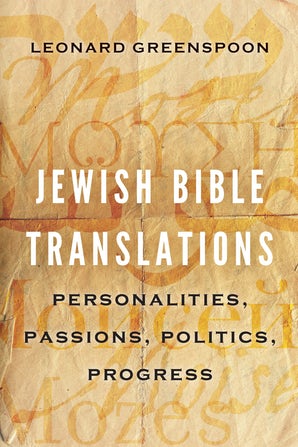
Jewish Bible Translations : Personalities, Passions, Politics, Progress by Leonard Greenspoon
Jewish Bible Translations is the first book to examine Jewish Bible translations from the third century BCE to our day. It is an overdue corrective of an important story that has been regularly omitted or downgraded in other histories of Bible translation.
Examining a wide range of translations over twenty-four centuries, Leonard Greenspoon delves into the historical, cultural, linguistic, and religious contexts of versions in eleven languages: Arabic, Aramaic, English, French, German, Greek, Hungarian, Italian, Russian, Spanish, and Yiddish. He profiles many Jewish translators, among them Buber, Hirsch, Kaplan, Leeser, Luzzatto, Mendelssohn, Orlinsky, and Saadiah Gaon, framing their aspirations within the Jewish and larger milieus in which they worked.
Greenspoon differentiates their principles, styles, and techniques—for example, their choice to emphasize either literal reflections of the Hebrew or distinctive elements of the vernacular language—and their underlying rationales. As he highlights distinctive features of Jewish Bible translations, he offers new insights regarding their shared characteristics and their limits. Additionally, Greenspoon shows how profoundly Jewish translators and interpreters influenced the style and diction of the King James Bible.
Accessible and authoritative for all from beginners to scholars, Jewish Bible Translations enables readers to make their own informed evaluations of individual translations and to holistically assess Bible translation within Judaism.
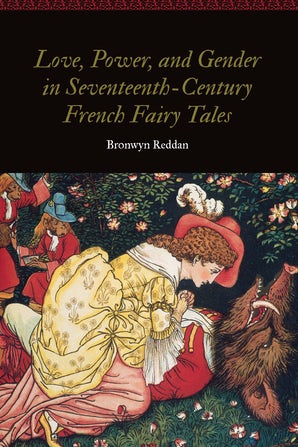
Love, Power, and Gender in Seventeenth-Century French Fairy Tales by Bronwyn Reddan (Series: Women and Gender in the Early Modern World)
Love is a key ingredient in the stereotypical fairy-tale ending in which everyone lives happily ever after. This romantic formula continues to influence contemporary ideas about love and marriage, but it ignores the history of love as an emotion that shapes and is shaped by hierarchies of power including gender, class, education, and social status. This interdisciplinary study questions the idealization of love as the ultimate happy ending by showing how the conteuses, the women writers who dominated the first French fairy-tale vogue in the 1690s, used the fairy-tale genre to critique the power dynamics of courtship and marriage. Their tales do not sit comfortably in the fairy-tale canon as they explore the good, the bad, and the ugly effects of love and marriage on the lives of their heroines.
Bronwyn Reddan argues that the conteuses’ scripts for love emphasize the importance of gender in determining the “right” way to love in seventeenth-century France. Their version of fairy-tale love is historical and contingent rather than universal and timeless. This conversation about love compels revision of the happily-ever-after narrative and offers incisive commentary on the gendered scripts for the performance of love in courtship and marriage in seventeenth-century France.
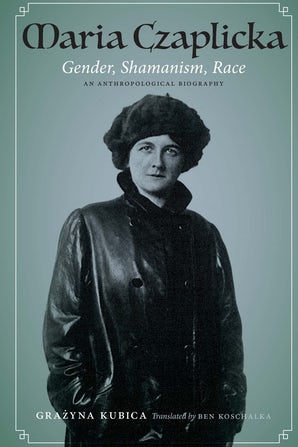
Maria Czaplicka : Gender, Shamanism, Race by Grazyna Kubica ; Translated by Ben Koschalka (Series: Critical Studies in the History of Anthropology)
This biography of the Polish British anthropologist Maria Czaplicka (1884–1921) is also a cultural study of the dynamics of the anthropological collective presented from a researcher-centric perspective. Czaplicka, together with Bronisław Malinowski, studied anthropology in London and later at Oxford, then she headed the Yenisei Expedition to Siberia (1914–15) and was the first female lecturer of anthropology at Oxford. She was an engaged feminist and an expert on political issues in Northern Asia and Eastern Europe. But this remarkable woman’s career was cut short by suicide. Like many women anthropologists of the time, Czaplicka journeyed through various academic institutions, and her legacy has been dispersed and her field materials lost.
Grażyna Kubica covers the major events in Czaplicka’s life and provides contextual knowledge about the intellectual formation in which Czaplicka grew up, including the Warsaw radical intelligentsia and the contemporary anthropology of which she became a part. Kubica also presents a critical analysis of Czaplicka’s scientific and literary works, related to the issues of gender, shamanism, and race. Kubica shows how Czaplicka’s sense of agency and subjectivity enriched and shaped the practice of anthropology and sheds light on how scientific knowledge arises and is produced.
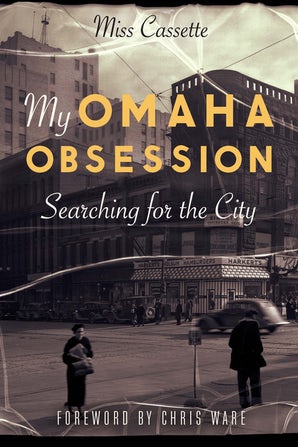
My Omaha Obsession : Searching for the City by Miss Cassette
My Omaha Obsession takes the reader on an idiosyncratic tour through some of Omaha’s neighborhoods, buildings, architecture, and people, celebrating the city’s unusual history. Rather than covering the city’s best-known sites, Miss Cassette is irresistibly drawn to strange little buildings and glorious large homes that don’t exist anymore as well as to stories of Harkert’s Holsum Hamburgers and the Twenties Club.
Piecing together the records of buildings and homes and everything interesting that came after, Miss Cassette shares her observations of the property and its significance to Omaha. She scrutinizes land deeds, insurance maps, tax records, and old newspaper articles to uncover a property’s singular story. Through conversations with fellow detectives and history enthusiasts, she guides readers along her path of hunches, personal interests, mishaps, and more.
As a longtime resident of Omaha, Miss Cassette is informed by memories of her youth combined with an enduring curiosity about the city’s offbeat relics and remains. Part memoir and part research guide with a healthy dose of colorful wandering, My Omaha Obsession celebrates the historic built environment and searches for the people who shaped early Omaha.
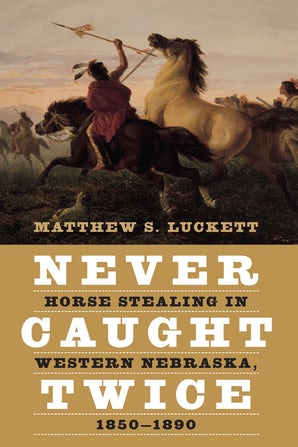
Never Caught Twice : Horse Stealing in Western Nebraska, 1850-1890 by Matthew S. Luckett
Never Caught Twice presents the untold history of horse raiding and stealing on the Great Plains of western Nebraska. By investigating horse stealing by and from four Plains groups—American Indians, the U.S. Army, ranchers and cowboys, and farmers—Matthew S. Luckett clarifies a widely misunderstood crime in Western mythology and shows that horse stealing transformed plains culture and settlement in fundamental and surprising ways.
From Lakota and Cheyenne horse raids to rustling gangs in the Sandhills, horse theft was widespread and devastating across the region. The horse’s critical importance in both Native and white societies meant that horse stealing destabilized communities and jeopardized the peace throughout the plains, instigating massacres and murders and causing people to act furiously in defense of their most expensive, most important, and most beloved property. But as it became increasingly clear that no one legal or military institution could fully control it, would-be victims desperately sought a solution that would spare their farms and families from the calamitous loss of a horse. For some, that solution was violence. Never Caught Twice shows how the story of horse stealing across western Nebraska and the Great Plains was in many ways the story of the old West itself.
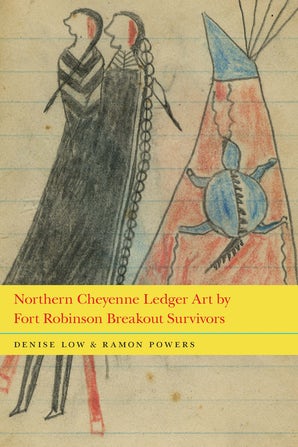
Northern Cheyenne Ledger Art by Fort Robinson Breakout Survivors by Denise Low and Ramon Powers
Northern Cheyenne Ledger Art by Fort Robinson Breakout Survivors presents the images of Native warriors—Wild Hog, Porcupine, and Left Hand, as well as possibly Noisy Walker (or Old Man), Old Crow, Blacksmith, and Tangled Hair—as they awaited probable execution in the Dodge City jail in 1879. When Sheriff Bat Masterson provided drawing materials, the men created war books that were coded to avoid confrontation with white authorities and to narrate survival from a Northern Cheyenne point of view. The prisoners used the ledger-art notebooks to maintain their cultural practices during incarceration and as gifts and for barter with whites in the prison where they struggled to survive.
The ledger-art notebooks present evidence of spiritual practice and include images of contemporaneous animals of the region, hunting, courtship, dance, social groupings, and a few war-related scenes. Denise Low and Ramon Powers include biographical materials from the imprisonment and subsequent release, which extend the historical arc of Northern Cheyenne heroes of the Plains Indian Wars into reservation times. Sources include selected ledger drawings, army reports, letters, newspapers, and interviews with some of the Northern Cheyenne men and their descendants. Accounts from a firsthand witness of the drawings and composition of the ledgers themselves give further information about Native perspectives on the conflicted history of the North American West in the nineteenth century and beyond.
This group of artists jailed after the tragedy of the Fort Robinson Breakout have left a legacy of courage and powerful art.
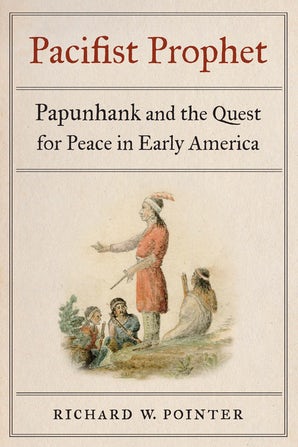
Pacifist Prophet : Paunhank and the Quest for Peace in Early America by Richard W. Pointer
Pacifist Prophet recounts the untold history of peaceable Native Americans in the eighteenth century, as explored through the world of Papunhank (ca. 1705–75), a Munsee and Moravian prophet, preacher, reformer, and diplomat. Papunhank’s life was dominated by a search for a peaceful homeland in Pennsylvania and the Ohio country amid the upheavals of the era between the Seven Years’ War and the American Revolution.
His efforts paralleled other Indian quests for autonomy but with a crucial twist: he was a pacifist committed to using only nonviolent means. Such an approach countered the messages of other Native prophets and ran against the tide in an early American world increasingly wrecked with violence, racial hatred, and political turmoil. Nevertheless, Papunhank was not alone. He followed and contributed to a longer and wider indigenous peace tradition.
Richard W. Pointer shows how Papunhank pushed beyond the pragmatic pacifism of other Indians and developed from indigenous and Christian influences a principled pacifism that became the driving force of his life and leadership. Hundreds of Native people embraced his call to be “a great Lover of Peace” in their quests for home. Against formidable odds, Papunhank’s prophetic message spoke boldly to Euro-American and Native centers of power and kept many Indians alive during a time when their very survival was constantly threatened. Papunhank’s story sheds critical new light on the responses of some Munsees, Delawares, Mahicans, Nanticokes, and Conoys for whom the “way of war” was no way at all.
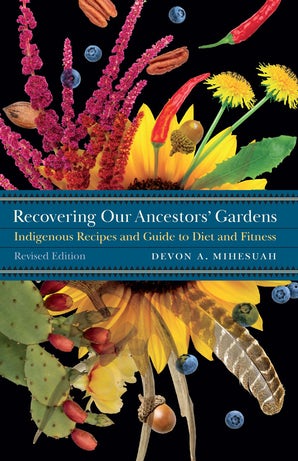
Recovering Our Ancestors’ Gardens : Indigenous Recipes and Guide to Diet and Fitness by Devon A. Mihesuah
2020 Gourmand World Cookbook Award
Winner of the Gourmand International World Cookbook Award,Recovering Our Ancestors’ Gardens is back! Featuring an expanded array of tempting recipes of indigenous ingredients and practical advice about health, fitness, and becoming involved in the burgeoning indigenous food sovereignty movement, the acclaimed Choctaw author and scholar Devon A. Mihesuah draws on the rich indigenous heritages of this continent to offer a helpful guide to a healthier life.
Recovering Our Ancestors’ Gardens features pointed discussions about the causes of the generally poor state of indigenous health today. Diminished health, Mihesuah contends, is a pervasive consequence of colonialism, but by advocating for political, social, economic, and environmental changes, traditional food systems and activities can be reclaimed and made relevant for a healthier lifestyle today.
New recipes feature pawpaw sorbet, dandelion salad, lima bean hummus, cranberry pie with cornmeal crust, grape dumplings, green chile and turkey posole, and blue corn pancakes, among other dishes. Savory, natural, and steeped in the Native traditions of this land, these recipes are sure to delight and satisfy.
This new edition is revised, updated, and contains new information, new chapters, and an extensive curriculum guide that includes objectives, resources, study questions, assignments, and activities for teachers, librarians, food sovereignty activists, and anyone wanting to know more about indigenous foodways.
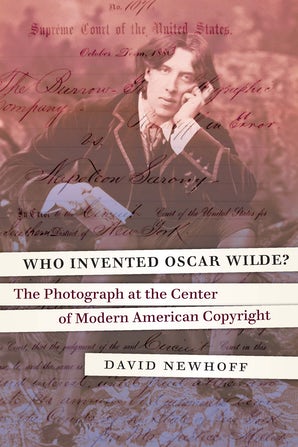
Who Invented Oscar Wilde? : The Photograph at the Center of Modern American Copyright by David Newhoff
In early 1882, before young Oscar Wilde embarked on his lecture tour across America, he posed for publicity photos taken by a famously eccentric New York photographer named Napoleon Sarony. Few would guess that one of those photographs would become the subject of the Supreme Court case that challenged copyright protection for all photography—a constitutional question that asked how a machine-made image could possibly be a work of human creativity.
Who Invented Oscar Wilde? is a story about the nature of authorship and the “convenient fiction” we call copyright. While a seemingly obscure topic, copyright has been a hotly contested issue almost since the day the internet became publicly accessible. The presumed obsolescence of authorial rights in this age of abundant access has fueled a debate that reaches far beyond the question of compensation for authors of works. Much of the literature on the subject is either highly academic, highly critical of copyright, or both.
With a light and balanced touch, David Newhoff makes a case for intellectual property law, tracing the concept of authorship from copyright’s ancient beginnings to its adoption in American culture to its eventual confrontation with photography and its relevance in the digital age. Newhoff tells a little-known story that will appeal to a broad spectrum of interests while making an argument that copyright is an essential ingredient to upholding the principles on which liberal democracy is founded.
**All book covers and synopses courtesy of University of Nebraska Press (https://www.nebraskapress.unl.edu/)
What’s Up Doc? New State Agency Publications at the Nebraska Library Commission

New state agency publications have been received at the Nebraska Library Commission for September through December 2020. Included are reports from the Nebraska Auditor of Public Accounts, the Nebraska Department of Economic Development, the Nebraska Legislature, the Nebraska Department of Transportation, and new books from the University of Nebraska Press, to name a few.
Most items, except the books from the University of Nebraska Press, are available for immediate viewing and printing by clicking on the highlighted link above, or directly in the .pdf below. You can read synopses of the books received from the University of Nebraska Press in the Book Briefs blogposts.
The Nebraska Legislature created the Nebraska Publications Clearinghouse in 1972, a service of the Nebraska Library Commission. Its purpose is to collect, preserve, and provide access to all public information published by Nebraska state agencies. By law (State Statutes 51-411 to 51-413) all Nebraska state agencies are required to submit their published documents to the Clearinghouse. For more information, visit the Nebraska Publications Clearinghouse page, contact Mary Sauers, Government Information Services Librarian; or contact Bonnie Henzel, State Documents Staff Assistant.
Book Briefs: New University of Nebraska Press Books at the Nebraska Publications Clearinghouse

The Nebraska Publications Clearinghouse receives documents every month from all Nebraska state agencies, including the University of Nebraska Press (UNP). Each month we will be showcasing the UNP books that the Clearinghouse receives. UNP books, as well as all Nebraska state documents, are available for checkout by libraries and librarians for their patrons.
Here are the UNP books the Clearinghouse received in September and October 2020:
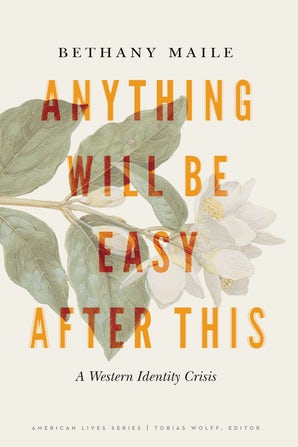
Anything Will Be Easy After This : A Western Identity Crisis Bethany Maile (Series: American Lives)
Bethany Maile had a mythological American West in mind when she returned to Idaho after dropping out of college in Boston, only to find a farm-town-turned-suburb instead of the Wild West wonderland she remembered. Haunted by what she had so completely misremembered, Maile resolved to investigate her attachment to the western myth, however flawed.
Deciding to engage in a variety of “western” events, Maile trailed rodeo queens, bid on cattle, fired .22s at the gun range, and searched out wild horses. With lively reportage and a sharp wit, she recounts her efforts to understand how the western myth is outdated yet persistent while ultimately exploring the need for story and the risks inherent to that need. Anything Will Be Easy after This traces Maile’s evolution from a girl suckered by a busted-down story to a more knowing woman who discovers a new narrative that enchants without deluding.
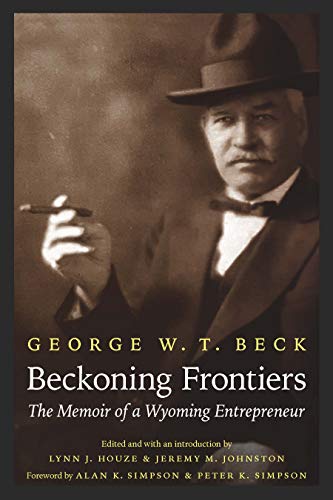
Beckoning Frontiers : The Memoir of a Wyoming Entrepreneur George W. T. Beck, Edited and with an introduction by Lynn J. Houze and Jeremy M. Johnston (Series: The Papers of William F. “Buffalo Bill” Cody)
George W. T. Beck, an influential rancher and entrepreneur in the American West, collaborated with William F. “Buffalo Bill” Cody to establish the town of Cody, Wyoming, in the 1890s. He advanced his financial investments in Wyoming through his numerous personal and professional contacts with various eastern investors and politicians in Washington DC. Beck’s family—his father a Kentucky senator and his mother a grandniece of George Washington—and his adventures in the American West resulted in personal associates who ranged from western legends Buffalo Bill, Jesse James, and Calamity Jane to wealthy American elites such as George and Phoebe Hearst and Theodore Roosevelt.
This definitive edition of Beck’s memoir provides a glimpse of early life in Wyoming, offering readers a rare perspective on how community boosters cooperated with political leaders and wealthy financiers. Beck’s memoir, introduced and annotated by Lynn J. Houze and Jeremy M. Johnston, offers a unique and sometimes amusing view of financial dealings in eastern boardrooms, as well as stories of Beck’s adventures with Buffalo Bill in Wyoming. Beck’s memoir demonstrates not only his interest in developing the West but also his humor and his willingness to collaborate with a variety of people.
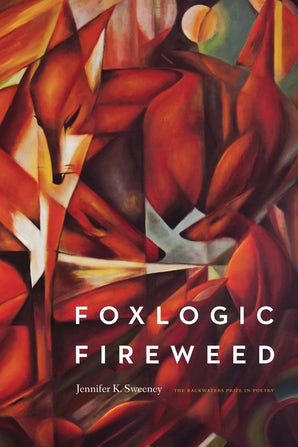
Foxlogic, Fireweed Jennifer K. Sweeney (Series: The Backwaters Prize in Poetry)
Winner of the Backwaters Prize in Poetry, Jennifer K. Sweeney’s Foxlogic, Fireweed follows a lyrical sequence of five physical and emotional terrains—floodplain, coast, desert, suburbia, and mesa—braiding themes of nature, domesticity, isolation, and human relationships. These are poems of the earth’s wild heart, its searing mysteries, its hollows, and its species, poems of the complex domestic space, of before and after motherhood, gun terror, the election, of dislocation and home, and of how we circle toward and away from our centers. Sweeney is not afraid to take up the domestic and inner lives of women, a nuanced relationship with the natural world that feels female or even maternal, or a duty to keeping alive poetry’s big questions of transcendence, revelation, awe, and deep presence in the ordinary.
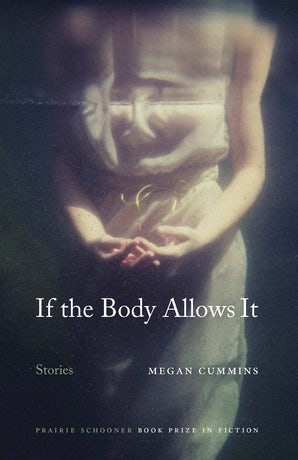
If the Body Allows It Megan Cummins (Series: Prairie Schooner Book Prize in Fiction
Winner of the Prairie Schooner Book Prize in Fiction, If the Body Allows It is divided into six parts and framed by the story of Marie, a woman in her thirties living in Newark, New Jersey. Suffering from a chronic autoimmune illness, she also struggles with guilt over the overdose and death of her father, whom she feels she betrayed at the end of his life. The stories within the frame—about failed marriages, places of isolation and protection, teenage mistakes, and forging a life in the aftermath—are the stories the narrator writes after she meets and falls in love with a man whose grief mirrors her own. If the Body Allows It explores illness and its aftermath, guilt and addiction, and the relationships the characters form after they’ve lost everyone else, including themselves.
Introspective, devastating, and funny, If the Body Allows It grapples with the idea that life is always on the brink of never being the same again.
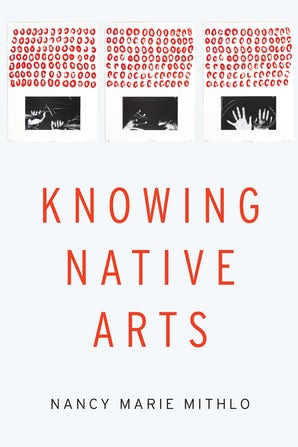
Knowing Native Arts Nancy Marie Mithlo
Knowing Native Arts brings Nancy Marie Mithlo’s Native insider perspective to understanding the significance of Indigenous arts in national and global milieus. These musings, written from the perspective of a senior academic and curator traversing a dynamic and at turns fraught era of Native self-determination, are a critical appraisal of a system that is often broken for Native peoples seeking equity in the arts.
Mithlo addresses crucial issues, such as the professionalization of Native arts scholarship, disparities in philanthropy and training, ethnic fraud, and the receptive scope of Native arts in new global and digital realms. This contribution to the field of fine arts broadens the scope of discussions and offers insights that are often excluded from contemporary appraisals.
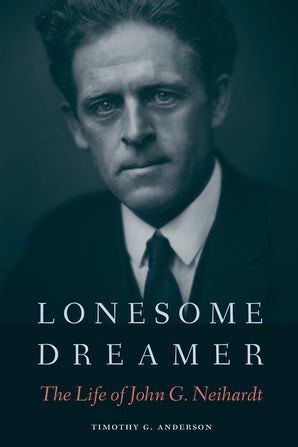
Lonesome Dreamer : the Life of John G. Neihardt Timothy G. Anderson
American poet and writer John G. Neihardt (1881–1973) possessed an inquiring and spiritual mind. Those qualities came to the fore in Black Elk Speaks, the story of the Lakota holy man Black Elk, for which he is best remembered. Over the course of thirty years he also wrote a five-volume epic poem, A Cycle of the West, which told the story of the settling of the American West.
Despite Neihardt’s widespread name recognition, the success of Black Elk Speaks, and a list of critically acclaimed books and poems, Lonesome Dreamer is the first biography of Neihardt in nearly forty years. Timothy G. Anderson describes Neihardt’s life from his humble beginnings in Illinois, to being named poet laureate of Nebraska in 1921, to his appearance on the Dick Cavett Show at the age of ninety. Anderson also delves into Neihardt’s success as a poet far from the East Coast literary establishment, his resistance to modernist movements in poetry, and his wish to understand and describe the experience of the Plains Indians. Offering insight into both his personal and his literary life, this biography reaffirms Neihardt’s place in American literary history, his successes and failures, and his unbreakable spirit.
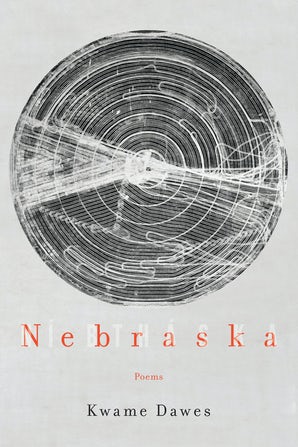
Nebraska : Poems Kwame Dawes
Kwame Dawes is not a native Nebraskan. Born in Ghana, he later moved to Jamaica, where he spent most of his childhood and early adulthood. In 1992 he relocated to the United States and eventually found himself an American living in Lincoln, Nebraska.
In Nebraska, this beautiful and evocative collection of poems, Dawes explores a theme constant in his work—the intersection of memory, home, and artistic invention. The poems, set against the backdrop of Nebraska’s discrete cycle of seasons, are meditative even as they search for a sense of place in a new landscape. While he shovels snow or walks in the bitter cold to his car, he is engulfed with memories of Kingston, yet when he travels, he finds himself longing for the open space of the plains and the first snowfall. With a strong sense of place and haunting memories, Dawes grapples with life in Nebraska as a transplant.
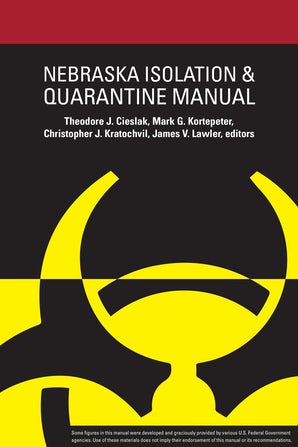
Nebraska Isolation & Quarantine Manual Edited by Theodore J. Cieslak, Mark G. Kortepeter, Christopher J. Kratochvil, and James V. Lawler
The University of Nebraska Medical Center has gained international recognition for its expertise in the control and management of highly infectious diseases, with a good deal of public attention given to its work during the 2014 Ebola outbreak in west Africa and now in 2020 with its biocontainment and treatment of more than a dozen cruise ship evacuees who were exposed to the coronavirus. The Nebraska Isolation and Quarantine Manual is a practical guide for local public health officials, emergency management personnel, and health care providers looking to implement evidence-based best practices in the event of an infectious disease outbreak.
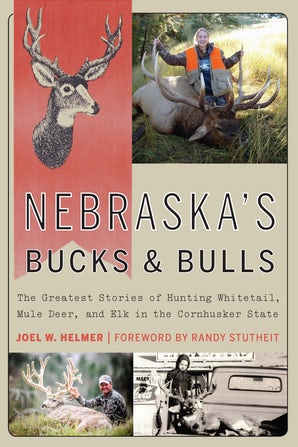
Nebraska’s Bucks & Bulls : the Greatest Stories of Hunting Whitetail, Mule Deer, and Elk in the Cornhusker State Joel W. Helmer
Eclipsing Memorial Stadium on a Husker football game day, deer season is arguably the largest single sporting event of the year in Nebraska, with more than one hundred thousand hunters going afield with the hopes of tagging a trophy buck or bull.
Nebraska’s Bucks and Bulls tells the stories and shares the photographs of the greatest whitetail, mule deer, and elk shot in Nebraska. Collected through firsthand interviews with the hunters, these personal hunting stories span the decades from the mid-1940s through the 2010s. Each story shares the excitement and adventure of the hunt while weaving in Nebraska history, ecology, and geography. Photographs of the trophy animals showcase not only the quality and variety of big-game hunting in Nebraska but also the changes in hunting clothes, gear, guns, and vehicles through the state’s history.
Recounted by Joel W. Helmer, an avid hunter and official measurer for the Boone and Crockett Club, which created the scoring system for measuring North American big-game animals, each chapter tells the story of a buck or bull certified through official state or national records books. Nebraska’s Bucks and Bulls has finally gathered the state’s greatest hunting tales in one place.
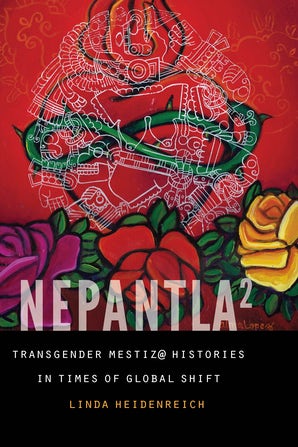
Nepantla Squared : Transgender Mestiz@ Histories in Times of Global Shift Linda Heidenreich (Series: Expanding Frontiers: Interdisciplinary Approaches to Studies of Women, Gender, and Sexuality)
Nepantla Squared maps the lives of two transgender mestiz@s, one during the turn of the twentieth century and one during the turn of the twenty-first century, to chart the ways race, gender, sex, ethnicity, and capital function differently in different times. To address the erasure of transgender mestiz@ realities from history, Linda Heidenreich employs an intersectional analysis that critiques monopoly and global capitalism. Heidenreich builds on the work of Gloria Anzaldúa’s concept of nepantleras, those who could live between and embody more than one culture, to coin the term nepantla², marking times of capitalist transition where gender was also in motion. Transgender mestiz@s, too, embodied that movement.
Heidenreich insists on a careful examination of the multiple in-between spaces that construct lives between cultures and genders during in-between times of shifting empire and capital. In so doing, they offer an important discussion of race, class, nation, and citizenship centered on transgender bodies of color that challenges readers to rethink the way they understand the gendered social and economic challenges of today.
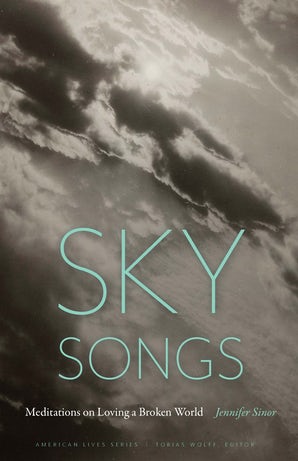
Sky Songs : Meditations on Loving a Broken World Jennifer Sinor (Series: American Lives)
Sky Songs is a collection of essays that takes inspiration from the ancient seabed in which Jennifer Sinor lives, an elemental landscape that reminds her that our lives are shaped by all that has passed through. Beginning with the conception of her first son, which coincided with the tragic death of her uncle on an Alaskan river, and ending a decade later in the Himalayan home of the Dalai Lama, Sinor offers a lyric exploration of language, love, and the promise inherent in the stories we tell: to remember.
In these essays, Sinor takes us through the mountains, deserts, and rivers of the West and along with her on her travels to India. Whether rooted in the dailiness of raising children or practicing yoga, Sinor searches for the places where grace resides. The essays often weave several narrative threads together in the search for relationship and connection. A mother, writer, teacher, and yoga instructor, Sinor ultimately tackles the most difficult question: how to live in a broken world filled with both suffering and grace.
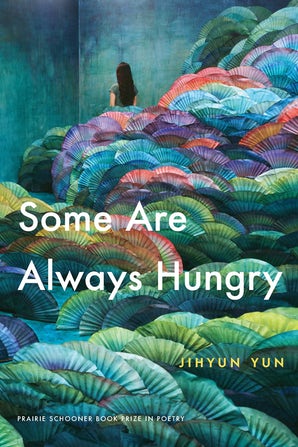
Some Are Always Hungry Jihyun Yun (Series: Prairie Schooner Book Prize in Poetry)
Winner of the Prairie Schooner Book Prize in Poetry, Some Are Always Hungry chronicles a family’s wartime survival, immigration, and heirloom trauma through the lens of food, or the lack thereof. Through the vehicle of recipe, butchery, and dinner table poems, the collection negotiates the myriad ways diasporic communities comfort and name themselves in other nations, as well as the ways cuisine is inextricably linked to occupation, transmission, and survival. Dwelling on the personal as much as the historical, Some Are Always Hungry traces the lineage of the speaker’s place in history and diaspora through mythmaking and cooking, which is to say, conjuring.
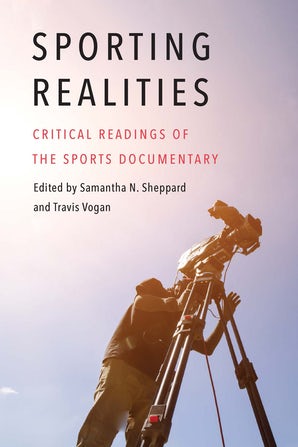
Sporting Realitites : Critical Readings of the Sports Documentary Edited by Samantha N. Sheppard and Travis Vogan (Series: Sports, Media, and Society)
Despite the increasing number of popular and celebrated sports documentaries in contemporary culture, such as ESPN’s 30 for 30 series, there has been little scholarly engagement with this genre. Sports documentaries, like all films, do not merely showcase objective reality but rather construct specific versions of sporting culture that serve distinct economic, industrial, institutional, historical, and sociopolitical ends ripe for criticism, contextualization, and exploration.
Sporting Realities brings together a diverse group of scholars to probe the sports documentary’s cultural meanings, aesthetic practices, industrial and commercial dimensions, and political contours across historical, social, medium-specific, and geographic contexts. It considers and critiques the sports documentary’s visible and powerful position in contemporary culture and forges novel connections between the study of nonfiction media and sport.
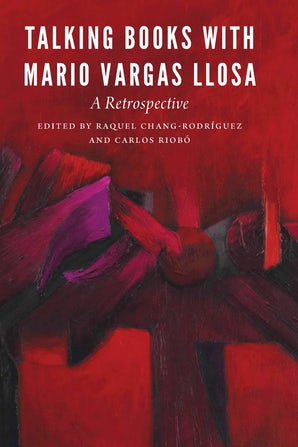
Talking Books with Mario Vargas Llosa : A Retrospective Edited by Raquel Chang-Rodríguez and Carlos Riobó (Series: New Hispanisms)
The essays included in Talking Books with Mario Vargas Llosa celebrate Mario Vargas Llosa’s visits to the City College of New York, the creation of the Cátedra Vargas Llosa in his honor, and the interests of the Peruvian author in reading and books. This volume contains previously unpublished material by Vargas Llosa himself, as well as by novelists and literary critics associated with the Cátedra.
This collection offers readers an opportunity to learn about Vargas Llosa’s body of work through multiple perspectives: his own and those of eminent fiction writers and important literary critics. The book offers significant analysis and rich conversation that bring to life many of the Nobel Laureate’s characters and provide insights into his writing process and imagination. As the last surviving member of the original group of writers of the Latin American Boom—which included Gabriel García Márquez, Carlos Fuentes, and Julio Cortázar—Vargas Llosa endures as a literary icon because his fiction has remained fresh and innovative. His prolific works span many different themes and subgenres.
A combination of literary analyses and anecdotal contributions in this volume reveal the little-known human and intellectual dimensions of Vargas Llosa the writer and Vargas Llosa the man.
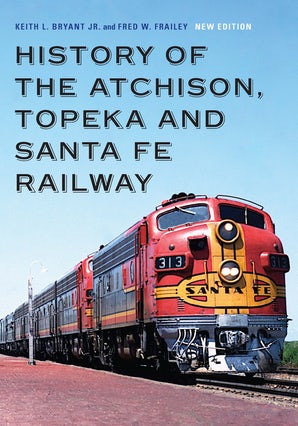
History of the Atchison, Topeka and Santa Fe Railway Keith L. Bryant Jr. and Fred W. Frailey
Cyrus K. Holliday envisioned a railroad that would run from Kansas to the Pacific, increasing the commerce and prosperity of the nation. With farsighted investors and shrewd management, the Atchison, Topeka and Santa Fe Railway grew from Holliday’s idea into a model of the modern, rapid, and efficient railroad. There were many growing pains early on, including rustlers, thieves, and desperadoes as well as the nineteenth century’s economic and climatic hardships. The railroad eventually extended from Chicago to San Francisco, with substantial holdings in oil fields, timber land, uranium mines, pipelines, and real estate.
This is the first comprehensive history of the iconic Atchison, Topeka and Santa Fe Railway, from its birth in 1859 to its termination in 1996. This volume discusses the construction and operation of the railway, the strategies of its leaders, the evolution of its locomotive fleet, and its famed passenger service with partner Fred Harvey. The vast changes within the nation’s railway system led to a merger with the Burlington Northern and the creation of the BNSF Railway.
An iconic railroad, the Santa Fe at its peak operated thirteen thousand miles of routes and served the southwestern region of the nation with the corporate slogan “Santa Fe All the Way.” This new edition covers almost twenty-five more years of history, including the merger of the Santa Fe and Burlington Northern railroads and new material on labor, minorities, and women on the carrier along with new and updated maps and photographs.
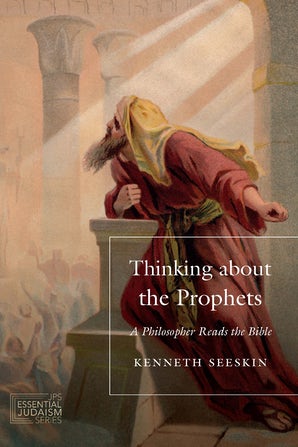
Thinking About the Prophets : A Philosopher Reads the Bible Kenneth Seeskin (Series: JPS Essential Judaism)
Rethinking the great literary prophets whose ministry ran from the eighth to the sixth centuries BCE—Amos, Hosea, First Isaiah, Jeremiah, Ezekiel, Second Isaiah, and Job—Thinking about the Prophets examines their often-shocking teachings in light of their times, their influence on later Western and Jewish thinkers, and their enduring lessons for all of us. As a noted scholar of Jewish philosophy, Kenneth Seeskin teases out philosophical, ethical, and theological questions in the writings, such as the nature of moral reasoning, the divine persona, divine providence, the suffering of the innocent, the power of repentance, and what it means to believe in a monotheistic conception of God.
Seeskin demonstrates that great ideas are not limited by time or place, but rather once put forth, take on a life of their own. Thus he interweaves the medieval and modern philosophers Maimonides, Kant, Cohen, Buber, Levinas, Heschel, and Soloveitchik, all of whom read the prophets and had important things to say as a result. We come to see the prophets perhaps in equal measure as divinely authorized whistle-blowers and profound thinkers of the human condition.
Readers of all levels will find this volume an accessible and provoking introduction to the enduring significance of biblical prophecy.
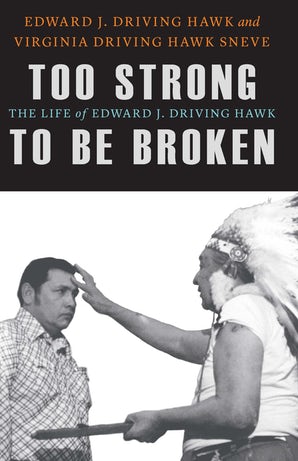
Too Strong To Be Broken : The Life of Edward J. Driving Hawk Edward J. Driving Hawk and Virginia Driving Hawk Sneve (Series: American Indian Lives)
Too Strong to Be Broken explores the dynamic life of Edward J. Driving Hawk, a Vietnam and Korean War veteran, chairman of the Rosebud Sioux Tribe, former president of the National Congress of American Indians, husband, father, recovered alcoholic, and convicted felon.
Driving Hawk’s story begins with his childhood on the rural plains of South Dakota, then follows him as he travels back and forth to Asia for two wars and journeys across the Midwest and Southwest. In his positions of leadership back in the United States, Driving Hawk acted in the best interest of his community, even when sparring with South Dakota governor Bill Janklow and the FBI.
After retiring from public service, he started a construction business and helped create the United States Reservation Bank and Trust. Unfortunately, a key participant in the bank embezzled millions and fled, leaving Driving Hawk to take the blame. Rather than plead guilty to a crime he did not commit, the seventy-four-year-old grandfather went to prison for a year and a day, even as he suffered the debilitating effects of Agent Orange.
Driving Hawk fully believes that the spirits of his departed ancestors watched out for him during his twenty-year career in the U.S. Air Force, including his exposure to Agent Orange, and throughout his life as he survived surgeries, strokes, a tornado, a plane crash, and alcoholism. With the help of his sister, Virginia Driving Hawk Sneve, Driving Hawk recounts his life’s story alongside his wife, Carmen, and their five children.
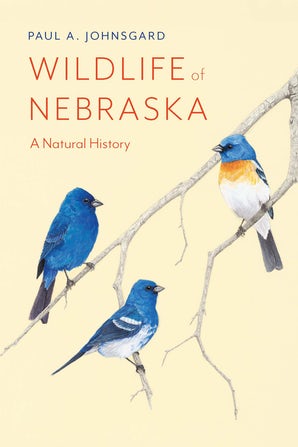
Wildlife of Nebraska : A Natural History Paul A. Johnsgard
In Wildlife of Nebraska: A Natural History, Paul A. Johnsgard surveys the variety and biology of more than six hundred Nebraska species. Narrative accounts describe the ecology and biology of the state’s birds, its mammals, and its reptiles and amphibians, summarizing the abundance, distributions, and habitats of this wildlife. To provide an introduction to the state’s major ecosystems, climate, and topography, Johnsgard examines major public-access natural areas, including national monuments, wildlife refuges and grasslands, state parks and wildlife management areas, and nature preserves.
Including more than thirty-five line drawings by the author along with physiographic, ecological, and historical maps, Wildlife of Nebraska is an essential guide to the wildlife of the Cornhusker State.
**
All book covers and synopses courtesy of University of Nebraska Press (https://www.nebraskapress.unl.edu/)
Friday Reads: The Bookseller, by Cynthia Swanson
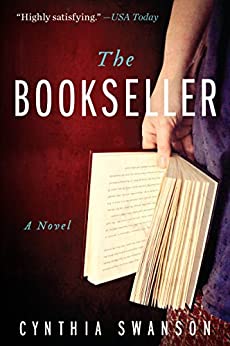
I am almost always drawn to books with the words book, bookshop, library or librarian in the title. The Bookseller, by Cynthia Swanson, caught my attention first with the title, then the unusual plot, then the location. Having lived in the Denver area for 22 years, this book was like walking down familiar streets again. I was hooked from the very first page, and I was 7/8’s of the way through before I figured out the awesome plot twist. I hope you enjoy it as much as I did!
Denver, 1962: Kitty Miller has come to terms with her unconventional single life. She loves the bookshop she runs with her best friend, Frieda, and enjoys complete control over her day-to-day existence. She can come and go as she pleases, answering to no one. There was a man once, a doctor named Kevin, but it didn’t quite work out the way Kitty had hoped.
Then the dreams begin.
Denver, 1963: Katharyn Andersson is married to Lars, the love of her life. They have beautiful children, an elegant home, and good friends. It’s everything Kitty Miller once believed she wanted—but it only exists when she sleeps.
Convinced that these dreams are simply due to her overactive imagination, Kitty enjoys her nighttime forays into this alternate world. But with each visit, the more irresistibly real Katharyn’s life becomes. Can she choose which life she wants? If so, what is the cost of staying Kitty, or becoming Katharyn?
As the lines between her worlds begin to blur, Kitty must figure out what is real and what is imagined, and learn to live with the result. (Amazon)
Nebraska Coronavirus Relief Fund (CRF) Program
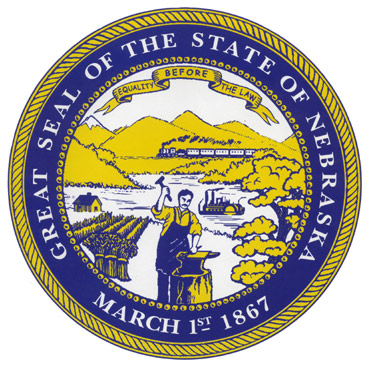
Online Program Information & Related Guidelines
As a result of the COVID-19 pandemic, entities across the government, businesses, and non-profit sectors continue to experience significant and unprecedented challenges to their operating capacity and sustainability. To help mitigate the impact of economic losses stemming from declining revenues, increased expenses, and employee lay offs or furloughs, the State of Nebraska has established a series of programs to help:
- Stabilize impacted businesses and livestock producers; and
- Support community institutions to meet critical needs such as food security, shelter, and mental health care;
This phase of funding will be available for select programs via online application beginning October 21, 2020:DHHS Administered Programs
- Stabilization Grant for Charitable Organizations and Licensed Providers, Round 2
- Healthy Places Grant for Centers of Worship, Round 2
DED Administered Programs
- Small Business Stabilization Program, Round 2
- Livestock Producers Stabilization Program, Round 2
- Hotels and Convention Centers Stabilization Program
- Event Centers and Sports Arenas Stabilization Program
- Restaurants and Bars Stabilization Program
- Licensed Personal Service Business Stabilization Program
- Movie Theatre Stabilization Program
Contact Center Assistance
Beginning October 21, 2020 from 10 AM to 7 PM CT, Contact Agents will be available to address your questions about this next round of funding. A toll-free number will be released on this website at that time.
From October 22, the Contact Agents will be available Monday to Friday from 7am to 7pm CT.
2020 Census Update: 99.98% Complete Nationwide
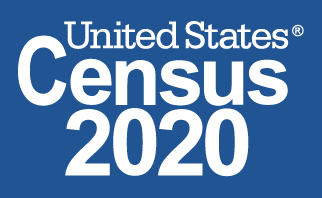
According to updated numbers released by the U.S. Census Bureau today, 99.98% of all housing units and addresses nationwide were accounted for in the 2020 Census as of the end of self-response and field data collection operations on Oct. 15, 2020. In all states, the District of Columbia and the Commonwealth of Puerto Rico, more than 99% of all addresses have been accounted for, and in all but one state that number tops 99.9%.
“The 2020 Census faced challenges like no other decennial census in living memory,” said Secretary of Commerce Wilbur L. Ross, Jr. “Achieving these metrics in the face of severe weather events and a global pandemic is a testament to the determination and ingenuity of the hundreds of thousands of dedicated women and men who worked on the 2020 Census.”
Compared to the final self-response rate of 66.5% for the 2010 Census, 67% were accounted for through self-response to date, with the rest having been accounted for through our Nonresponse Followup (NRFU) operation.
“America stepped up and answered the call: shape your future by responding to the 2020 Census,” said Dr. Steven Dillingham, Director of the Census Bureau. “Generally, better data comes from self-response, but after a decade of global decline in census and survey participation along with the challenges presented to communities by COVID-19, we had not expected to exceed the 2010 self-response rate. That we did is a testament to the American people, our nearly 400,000 national and community partners, and very importantly our staff.”
“The Census Bureau was able to meet and overcome many challenges because of our innovative design and use of new technology, but it could not be done without the unflinching resolve of our staff,” Dillingham continued. “We thank everyone on the team for their contributions, from the census takers and field staff going the extra mile to reach those hardest to count, to the dedicated operational leadership at headquarters and around the country working around the clock to maintain and protect our systems, process the data, oversee the operation, and get the word out about the importance of the 2020 Census.”
“We are especially proud of the hard work done to bring the state of Louisiana over 99% complete despite the devastating effects of hurricanes Laura and Delta, and of the partnership with American Indian and Alaska Native tribal governments to get 99.77% of the NRFU workload on their lands done, despite closures due to the pandemic.”
“Hundreds of millions of people were counted in the 2020 Census, and statisticians and data quality experts are now busy making sure everyone was counted once, only once, and in the right place,” Dillingham continued. “The Census Bureau will use the best methodologies available to resolve the very small number of unresolved addresses and to ensure that our data products are accurate.”
Each census, the Census Bureau produces coverage estimates and conduct extensive assessments that we share with the public. The completion rates are just early indicators. For more information on the 2020 Census, including use of proxy and administrative records, please see our updated FAQs.
The Census Bureau is working hard to process the data in order to deliver complete and accurate state population counts as close as possible to the Dec. 31, 2020, statutory deadline.
Data collection for the 2020 Census ended at 11:59 p.m. Hawaii Standard Time on Oct. 15, 2020 (5:59 a.m. EDT). Paper responses are still arriving and will be processed if postmarked by October 15, and received at the processing center no later than October 22.
For more information, visit 2020census.gov.
Posted in Books & Reading, Census, Education & Training, General, Information Resources, What's Up Doc / Govdocs
Tagged census
Leave a comment
Book Briefs: New University of Nebraska Press Books at the Nebraska Publications Clearinghouse

The Nebraska Publications Clearinghouse receives documents every month from all Nebraska state agencies, including the University of Nebraska Press (UNP). Each month we will be showcasing the UNP books that the Clearinghouse receives. UNP books, as well as all Nebraska state documents, are available for checkout by libraries and librarians for their patrons.
Here are the UNP books the Clearinghouse received in July and August 2020:
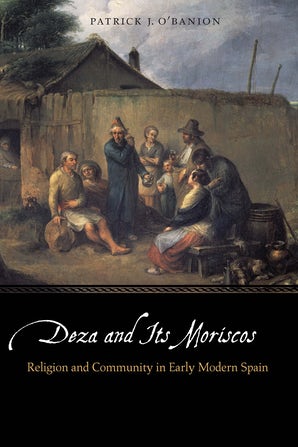
DEZA AND ITS MORISCOS : RELIGION AND COMMUNITY IN EARLY MODERN SPAIN. Patrick J. O’Banion (Series: Early Modern Cultural Studies)
Deza and Its Moriscos addresses an incongruity in early modern Spanish historiography: a growing awareness of the importance played by Moriscos in Spanish society and culture alongside a dearth of knowledge about individuals or local communities. By reassessing key elements in the religious and social history of early modern Spain through the experience of the small Castilian town of Deza, Patrick J. O’Banion asserts the importance of local history in understanding large-scale historical events and challenges scholars to rethink how marginalized people of the past exerted their agency.
Moriscos, baptized Muslims and their descendants, were pressured to convert to Christianity at the end of the Middle Ages but their mass baptisms led to fears about lingering crypto-Islamic activities. Many political and religious authorities, and many of the Moriscos’ neighbors as well, concluded that the conversions had produced false Christians. Between 1609 and 1614 nearly all of Spain’s Moriscos—some three hundred thousand individuals—were thus expelled from their homeland.
Contrary to the assumptions of many modern scholars, rich source materials show the town’s Morisco minority wielded remarkable social, economic, and political power. Drawing deeply on a diverse collection of archival material as well as early printed works, this study illuminates internal conflicts, external pressures brought to bear by the Inquisition, the episcopacy, and the crown, and the possibilities and limitations of negotiated communal life at the dawn of modernity.
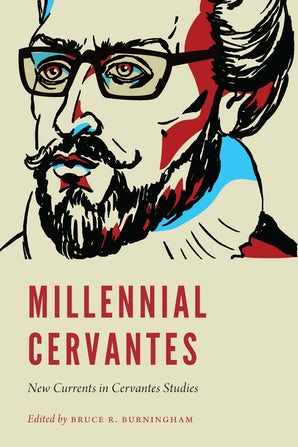
Millennial Cervantes : New Currents in Cervantes Studies Edited by Bruce R. Burningham (Series: New Hispanisms)
Millennial Cervantes explores some of the most important recent trends in Cervantes scholarship in the twenty-first century. It brings together leading Cervantes scholars of the United States in order to showcase their cutting-edge work within a cultural studies frame that encompasses everything from ekphrasis to philosophy, from sexuality to Cold War political satire, and from the culinary arts to the digital humanities.
Millennial Cervantes is divided into three sets of essays—conceptually organized around thematic and methodological lines that move outward in a series of concentric circles. The first group, focused on the concept of “Cervantes in his original contexts,” features essays that bring new insights to these texts within the primary context of early modern Iberian culture. The second group, focused on the concept of “Cervantes in comparative contexts,” features essays that examine Cervantes’s works in conjunction with those of the English-speaking world, both seventeenth- and twentieth-century. The third group, focused on the concept of “Cervantes in wider cultural contexts,” examines Cervantes’s works—principally Don Quixote—as points of departure for other cultural products and wider intellectual debates.
This collection articulates the state of Cervantes studies in the first two decades of the new millennium as we move further into a century that promises both unimagined technological advances and the concomitant cultural changes that will naturally adhere to this new technology, whatever it may be.
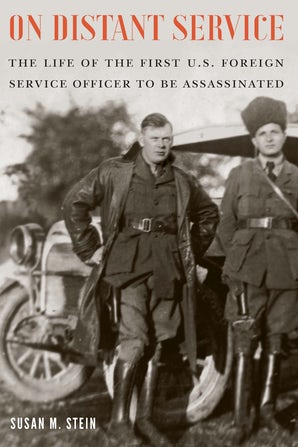
ON DISTANT SERVICE : THE LIFE OF THE FIRST U.S. FOREIGN SERVICE OFFICER TO BE ASSASSINATED. Susan M. Stein
On July 18, 1924, a mob in Tehran killed U.S. foreign service officer Robert Whitney Imbrie. His violent death, the first political murder in the history of the service, outraged the American people. Though Imbrie’s loss briefly made him a cause célèbre, subsequent events quickly obscured his extraordinary life and career.
Susan M. Stein tells the story of a figure steeped in adventure and history. Imbrie rejected a legal career to volunteer as an ambulance driver during World War I and joined the State Department when the United States entered the war. Assigned to Russia, he witnessed the October Revolution, fled ahead of a Bolshevik arrest order, and continued to track communist activity in Turkey even as the country’s war of independence unfolded around him. His fateful assignment to Persia led to his death at age forty-one and set off political repercussions that cloud relations between the United States and Iran to this day.
Drawing on a wealth of untapped materials, On Distant Service returns readers to an era when dash and diplomacy went hand-in-hand.
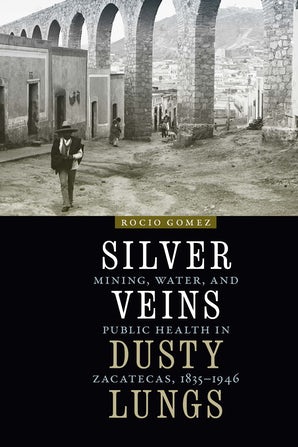
SILVER VEIN, DUSTY LUNGS : MONING, WATER, AND PUBLIC HEALTH IN ZACATECAS, 1835-1946. Rocio Gomez (Series: The Mexican Experience)
In Mexico environmental struggles have been fought since the nineteenth century in such places as Zacatecas, where United States and European mining interests have come into open conflict with rural and city residents over water access, environmental health concerns, and disease compensation.
In Silver Veins, Dusty Lungs, Rocio Gomez examines the detrimental effects of the silver mining industry on water resources and public health in the city of Zacatecas and argues that the human labor necessary to the mining industry made the worker and the mine inseparable through the land, water, and air. Tensions arose between farmers and the mining industry over water access while the city struggled with mudslides, droughts, and water source contamination. Silicosis-tuberculosis, along with accidents caused by mining technologies like jackhammers and ore-crushers, debilitated scores of miners. By emphasizing the perspective of water and public health, Gomez illustrates that the human body and the environment are not separate entities but rather in a state of constant interaction.
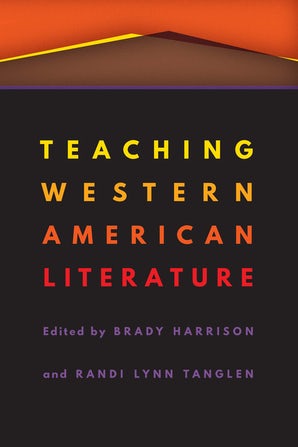
Teaching Western American Literature Edited by Brady Harrison and Randi Lynn Tanglen (Series: Postwestern Horizons)
In this volume experienced and new college- and university-level teachers will find practical, adaptable strategies for designing or updating courses in western American literature and western studies. Teaching Western American Literature features the latest developments in western literary research and cultural studies as well as pedagogical best practices in course development. Contributors provide practical models and suggestions for courses and assignments while presenting concrete strategies for teaching works both inside and outside the canon. In addition, Brady Harrison and Randi Lynn Tanglen have assembled insights from pioneering western studies instructors with workable strategies and practical advice for translating this often complex material for classrooms from freshman writing courses to graduate seminars.
Teaching Western American Literature reflects the cutting edge of western American literary study, featuring diverse approaches allied with women’s, gender, queer, environmental, disability, and Indigenous studies and providing instructors with entrée into classrooms of leading scholars in the field.
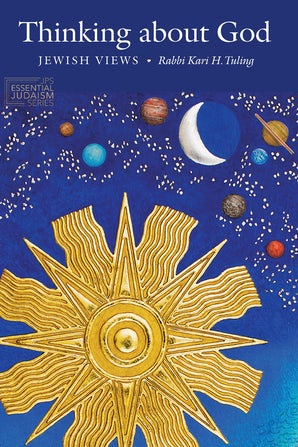
THINKING ABOUT GOD : JEWISH VIEWS. Rabbi Kari H. Tuling (Series: JPS Essential Judaism)
Who—or what—is God? Is God like a person? Does God have a gender? Does God have a special relationship with the Jewish people? Does God intervene in our lives? Is God good—and, if yes, why does evil persist in the world? In investigating how Jewish thinkers have approached these and other questions, Rabbi Kari H. Tuling elucidates many compelling—and contrasting—ways of thinking about God in Jewish tradition.
Thinking about God addresses the genuinely intertextual nature of evolving Jewish God concepts. Just as in Jewish thought the Bible and other historical texts are living documents, still present and relevant to the conversation unfolding now, and just as a Jewish theologian examining a core concept responds to the full tapestry of Jewish thought on the subject all at once, this book is organized topically, covers Jewish sources (including liturgy) from the biblical to the postmodern era, and highlights the interplay between texts over time, up through our own era.
A highly accessible resource for introductory students, Thinking about God also makes important yet challenging theological texts understandable. By breaking down each selected text into its core components, Tuling helps the reader absorb it both on its own terms and in the context of essential theological questions of the ages. Readers of all backgrounds will discover new ways to contemplate God.
**All book covers and synopses courtesy of University of Nebraska Press (https://www.nebraskapress.unl.edu/)
What’s Up Doc? New State Agency Publications at the Nebraska Library Commission

New state agency publications have been received at the Nebraska Library Commission for July and August 2020. Included are reports from the Nebraska Abstracters Board of Examiners, the Nebraska State Board of Public Accountancy, the Nebraska Accountability and Disclosure Commission, the Nebraska Commission for the Deaf and Hard of Hearing, and new books from the University of Nebraska Press, to name a few.
Most items, except the books from the University of Nebraska Press, are available for immediate viewing and printing by clicking on the highlighted link above, or directly in the .pdf below. You can read synopses of the books received from the University of Nebraska Press in the Book Briefs blogposts.
The Nebraska Legislature created the Nebraska Publications Clearinghouse in 1972, a service of the Nebraska Library Commission. Its purpose is to collect, preserve, and provide access to all public information published by Nebraska state agencies. By law (State Statutes 51-411 to 51-413) all Nebraska state agencies are required to submit their published documents to the Clearinghouse. For more information, visit the Nebraska Publications Clearinghouse page, contact Mary Sauers, Government Information Services Librarian; or contact Bonnie Henzel, State Documents Staff Assistant.
Friday Reads: The Lending Library, by Aliza Fogelson

What would you do if your town library closed for renovations, and the nearest library is an hour’s drive away? Read The Lending Library, by Aliza Fogelson to find out what one women did in just such a situation…
When the Chatsworth library closes indefinitely, Dodie Fairisle loses her sanctuary. How is a small-town art teacher supposed to cope without the never-ending life advice and enjoyment that books give her? Well, when she’s as resourceful and generous as Dodie, she turns her sunroom into her very own little lending library.
At first just a hobby, this lit lovers’ haven opens up her world in incredible ways. She knows books are powerful, and soon enough they help her forge friendships between her zany neighbors—and attract an exciting new romance.
But when the chance to adopt an orphaned child brings Dodie’s secret dream of motherhood within reach, everything else suddenly seems less important. Finding herself at a crossroads, Dodie must figure out what it means to live a full, happy life. If only there were a book that could tell her what to do…
I read The Lending Library, by Aliza Fogelson, in the Kindle format, and thoroughly enjoyed it. This is a lovely debut novel that teaches us how important libraries are to individuals, families, friends, and communities. Definitely an excellent read!
Book Briefs: New University of Nebraska Press Books at the Nebraska Publications Clearinghouse

The Nebraska Publications Clearinghouse receives documents every month from all Nebraska state agencies, including the University of Nebraska Press (UNP). Each month we will be showcasing the UNP books that the Clearinghouse receives. UNP books, as well as all Nebraska state documents, are available for checkout by libraries and librarians, for their patrons, in Nebraska.
Here are the UNP books the Clearinghouse received in May and June 2020:
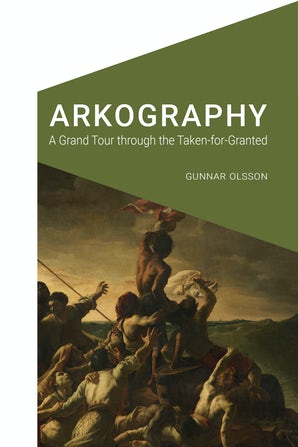
Arkography : A Grand Tour Through the Taken-for-Granted Gunnar Olsson (Series: Cultural Geographies + Rewriting the Earth)
In this fascinating text Gunnar Olsson tells the story of an arkographer, who with Pallas Athene’s blessings, travels down the Red River Valley, navigates the Kantian Island of Truth, and takes a house-tour through the Crystal Palace, the latter edifice an imagination grown out of Gunnael Jensson’s sculpture Mappa Mundi Universalis. This travel story carries the arkographer from the oldest creation epics extant to the power struggles of today—nothing less than a codification of the taken-for-granted, a mapping of the no-man’s-land between the five senses of the body and the sixth sense of culture. By constantly asking how we are made so obedient and predictable, the explorer searches for the present-day counterparts to the biblical ark, the chest that held the commandments and the rules of behavior that came with them—hence the term “arkography,” a word hinting at an as-yet-unrecognized discipline.
In Arkography Olsson strips bare the governing techniques of self-declared authorities, including those of the God of the Old Testament and countless dictators, the latter supported by a horde of lackeys often disguised as elected representatives and governmental functionaries. From beginning to end, Arkography is an illustration of how every creation epic is a variation on the theme of chaos turning into cosmic order. A palimpsest of layered meanings, a play of things and relations, identity and difference. One and many, you and me.
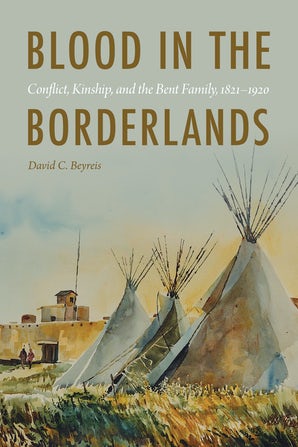
Blood in the Borderlands : Conflict, Kinship, and the Bent Family, 1821-1920 David C. Beyreis
The Bents might be the most famous family in the history of the American West. From the 1820s to 1920 they participated in many of the major events that shaped the Rocky Mountains and Southern Plains. They trapped beaver, navigated the Santa Fe Trail, intermarried with powerful Indian tribes, governed territories, became Indian agents, fought against the U.S. government, acquired land grants, and created historical narratives.
The Bent family’s financial and political success through the mid-nineteenth century derived from the marriages of Bent men to women of influential borderland families—New Mexican and Southern Cheyenne. When mineral discoveries, the Civil War, and railroad construction led to territorial expansions that threatened to overwhelm the West’s oldest inhabitants and their relatives, the Bents took up education, diplomacy, violence, entrepreneurialism, and the writing of history to maintain their status and influence.
In Blood in the Borderlands David C. Beyreis provides an in-depth portrait of how the Bent family creatively adapted in the face of difficult circumstances. He incorporates new material about the women in the family and the “forgotten” Bents and shows how indigenous power shaped the family’s business and political strategies as the family adjusted to American expansion and settler colonist ideologies. The Bent family history is a remarkable story of intercultural cooperation, horrific violence, and pragmatic adaptability in the face of expanding American power.
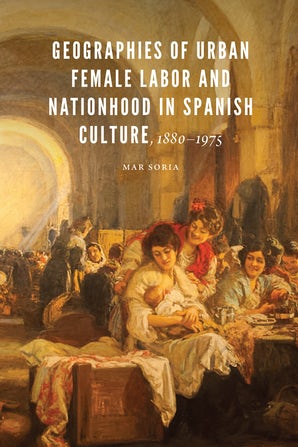
Geographies of Urban Female Labor and Nationhood in Spanish Culture, 1880-1975 Mar Soria (Series: New Hispanisms)
Mar Soria presents an innovative cultural analysis of female workers in Spanish literature and films. Drawing from nation-building theories, the work of feminist geographers, and ideas about the construction of the marginal subject in society, Soria examines how working women were perceived as Other in Spain from 1880 to 1975.
By studying the representation of these marginalized individuals in a diverse array of cultural artifacts, Soria contends that urban women workers symbolized the desires and anxieties of a nation caught between traditional values and rapidly shifting socioeconomic forces. Specifically, the representation of urban female work became a mode of reinforcing and contesting dominant discourses of gender, class, space, and nationhood in critical moments after 1880, when social and economic upheavals resulted in fears of impending national instability. Through these cultural artifacts Spaniards wrestled with the unresolved contradictions in the gender and class ideologies used to construct and maintain the national imaginary.
Whether for reasons of inattention or disregard of issues surrounding class dynamics, nineteenth- and twentieth-century Spanish literary and cultural critics have assumed that working women played only a minimal role in the development of Spain as a modern nation. As a result, relatively few critics have investigated cultural narratives of female labor during this period. Soria demonstrates that without considering the role working women played in the construction and modernization of Spain, our understanding of Spanish culture and life at that time remains incomplete.
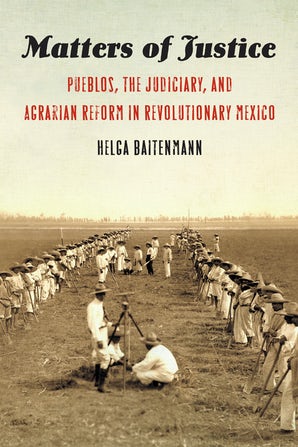
Matters of Justice : Pueblos, the Judiciary, and Agrarian Reform in Revolutionary Mexico Helga Baltenmann (Series: The Mexican Experience)
After the fall of the Porfirio Díaz regime, pueblo representatives sent hundreds of petitions to Pres. Francisco I. Madero, demanding that the executive branch of government assume the judiciary’s control over their unresolved lawsuits against landowners, local bosses, and other villages. The Madero administration tried to use existing laws to settle land conflicts but always stopped short of invading judicial authority.
In contrast, the two main agrarian reform programs undertaken in revolutionary Mexico—those implemented by Emiliano Zapata and Venustiano Carranza—subordinated the judiciary to the executive branch and thereby reshaped the postrevolutionary state with the support of villagers, who actively sided with one branch of government over another.
In Matters of Justice Helga Baitenmann offers the first detailed account of the Zapatista and Carrancista agrarian reform programs as they were implemented in practice at the local level and then reconfigured in response to unanticipated inter- and intravillage conflicts. Ultimately, the Zapatista land reform, which sought to redistribute land throughout the country, remained an unfulfilled utopia. In contrast, Carrancista laws, intended to resolve quickly an urgent problem in a time of war, had lasting effects on the legal rights of millions of land beneficiaries and accidentally became the pillar of a program that redistributed about half the national territory.
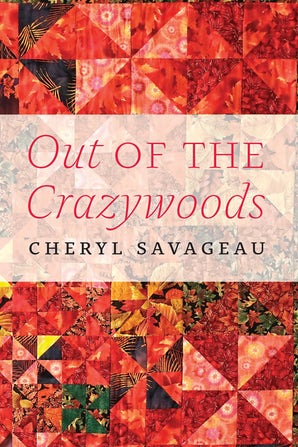
Out of the Crazywoods Cheryl Savageau (Series: American Indian Lives)
Out of the Crazywoods is the riveting and insightful story of Abenaki poet Cheryl Savageau’s late-life diagnosis of bipolar disorder. Without sensationalizing, she takes the reader inside the experience of a rapid-cycling variant of the disorder, providing a lens through which to understand it and a road map for navigating the illness. The structure of her story—impressionistic, fragmented—is an embodiment of the bipolar experience and a way of perceiving the world.
Out of the Crazywoods takes the reader into the euphoria of mania as well as its ugly, agitated rage and into “the lying down of desire” that is depression. Savageau articulates the joy of being consort to a god and the terror of being chased by witchcraft, the sound of voices that are always chattering in your head, the smell of wet ashes that invades your home, the perception that people are moving in slow motion and death lurks at every turnpike, and the feeling of being loved by the universe and despised by everyone you’ve ever known.
Central to the journey out of the Crazywoods is the sensitive child who becomes a poet and writer who finds clarity in her art and a reason to heal in her grandchildren. Her journey reveals the stigma and the social, personal, and economic consequences of the illness but reminds us that the disease is not the person. Grounded in Abenaki culture, Savageau questions cultural definitions of madness and charts a path to recovery through a combination of medications, psychotherapy, and ceremony.
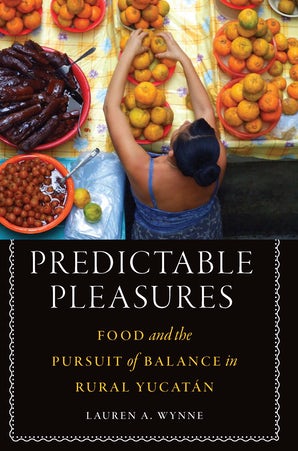
Predictable Pleasures : Food and the Pursuit of Balance In Rural Yucatan Lauren A Wynne (Series: At Table)
The pursuit of balance pervades everyday life in rural Yucatán, Mexico, from the delicate negotiations between a farmer and the neighbor who wants to buy his beans to the careful addition of sour orange juice to a rich plate of eggs fried in lard. Based on intensive fieldwork in one indigenous Yucatecan community, Predictable Pleasures explores the desire for balance in this region and the many ways it manifests in human interactions with food. As shifting social conditions, especially a decline in agriculture and a deepening reliance on regional tourism, transform the manners in which people work and eat, residents of this community grapple with new ways of surviving and finding pleasure.
Lauren A. Wynne examines the convergence of food and balance through deep analysis of what locals describe as acts of care. Drawing together rich ethnographic data on how people produce, exchange, consume, and talk about food, this book posits food as an accessible, pleasurable, and deeply important means by which people in rural Yucatán make clear what matters to them, finding balance in a world that seems increasingly imbalanced.
Unlike many studies of globalization that point to the dissolution of local social bonds and practices, Predictable Pleasures presents an array of enduring values and practices, tracing their longevity to the material constraints of life in rural Yucatán, the deep historical and cosmological significance of food in this region, and the stubborn nature of bodily habits and tastes.
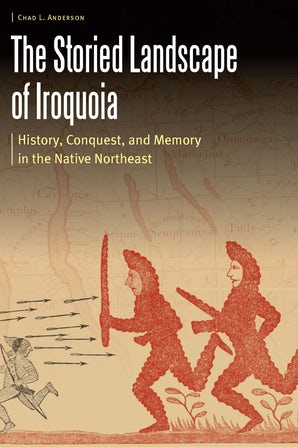
The Storied Landscape of Iroquoia : History, Conquest, and Memory in the Native Northeast Chad L. Anderson (Series: Borderlands and Transcultural Studies)
The Storied Landscape of Iroquoia explores the creation, destruction, appropriation, and enduring legacy of one of early America’s most important places: the homelands of the Haudenosaunees (also known as the Iroquois Six Nations). Throughout the late seventeenth, eighteenth, and early nineteenth centuries of European colonization the Haudenosaunees remained the dominant power in their homelands and one of the most important diplomatic players in the struggle for the continent following European settlement of North America by the Dutch, British, French, Spanish, and Russians. Chad L. Anderson offers a significant contribution to understanding colonialism, intercultural conflict, and intercultural interpretations of the Iroquoian landscape during this time in central and western New York.
Although American public memory often recalls a nation founded along a frontier wilderness, these lands had long been inhabited in Native American villages, where history had been written on the land through place-names, monuments, and long-remembered settlements. Drawing on a wide range of material spanning more than a century, Anderson uncovers the real stories of the people—Native American and Euro-American—and the places at the center of the contested reinvention of a Native American homeland. These stories about Iroquoia were key to both Euro-American and Haudenosaunee understandings of their peoples’ pasts and futures.
For more information about The Storied Landscape of Iroquoia, visit storiedlandscape.com.
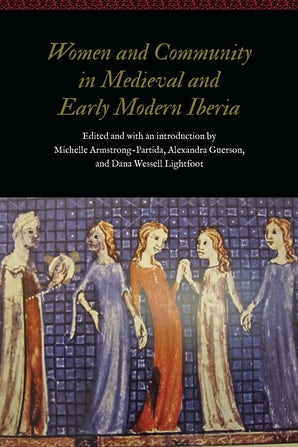
Women and Community in Medieval and Early Modern Iberia Edited and with an introduction by Michelle Armstrong-Partida, Alexandra Guerson, and Dana Wessell Lightfoot ; Series: Women and Gender in the Early Modern World
Women and Community in Medieval and Early Modern Iberia draws on recent research to underscore the various ways Iberian women influenced and contributed to their communities, engaging with a broader academic discussion of women’s agency and cultural impact in the Iberian Peninsula. By focusing on women from across the socioeconomic and religious spectrum—elite, bourgeois, and peasant Christian women, Jewish, Muslim, converso, and Morisco women, and married, widowed, and single women—this volume highlights the diversity of women’s experiences, examining women’s social, economic, political, and religious ties to their families and communities in both urban and rural environments.
Comprised of twelve essays from both established and new scholars, Women and Community in Medieval and Early Modern Iberia showcases groundbreaking work on premodern women, revealing the complex intersections between gender and community while highlighting not only relationships of support and inclusion but also the tensions that worked to marginalize and exclude women.
**All synopses courtesy of University of Nebraska Press (https://www.nebraskapress.unl.edu/)
What’s Up Doc? New State Agency Publications at the Nebraska Library Commission

New state agency publications have been received at the Nebraska Library Commission for May and June 2020. Included are audit reports from the Nebraska Auditor of Public Accounts, reports from the Nebraska Department of Economic Development, and new books from the University of Nebraska Press, to name a few.
Most items, except the books from the University of Nebraska Press, are available for immediate viewing and printing by clicking on the highlighted link above, or directly in the .pdf below. You can read synopses of the books received from the University of Nebraska Press in the Book Briefs blogposts.
The Nebraska Legislature created the Nebraska Publications Clearinghouse in 1972, a service of the Nebraska Library Commission. Its purpose is to collect, preserve, and provide access to all public information published by Nebraska state agencies. By law (State Statutes 51-411 to 51-413) all Nebraska state agencies are required to submit their published documents to the Clearinghouse. For more information, visit the Nebraska Publications Clearinghouse page, contact Mary Sauers, Government Information Services Librarian; or contact Bonnie Henzel, State Documents Staff Assistant.
Free ALA webinar: “Last Chance for a Complete Count”

| ALA is offering a webinar for library staff: 2020 Census: Last Chance for a Complete Count, on July 8 at 2 pm ET. Registration is free. After the session, the recording will be posted at ala.org/census. New guide on adapting census outreach in response to COVID-19: ALA released a new publication, “Libraries and the 2020 Census: Adapting Outreach in Response to COVID-19 (PDF).” The free guide explains changes to the 2020 Census process and highlights opportunities for libraries to adapt census outreach activities. Check your community’s response rate: How does your area compare in its response rate to date? Which neighborhoods are lagging behind? Find current data to inform your outreach and messages on the 2020 Census Response Rate Map or the Census 2020 Hard to Count Map. Share your event on the Census Counts calendar: Is your library planning a 2020 Census event (including virtual events)? Submit it to the national Census Counts calendar. Check the calendar for other events from partners in your community. |
Four Ways New Technology Is Revolutionizing the 2020 Census

From scribbled answers in 1790 to online responses in 2020, innovation has always been part of the Census. The Census Bureau has always been a leader in using, adapting and developing new technologies, but the 2020 Census will be the most sophisticated and high tech yet.
The census began in 1790 with collected information handwritten by U.S. Marshals visiting outposts in every corner of the new nation. Every decade since, the ways the U.S. Census Bureau has tried to meet its goal of counting every person living in the United States have undergone changes as dramatic as the growth of the nation itself.
Through the centuries, the decennial count progressed from in-person collections of handwritten answers to mass mailings of paper questionnaires in 1970. Among other changes along the way: creation of an electrical punch card tabulator for the 1890 Census and the first use by a government agency of the world’s first modern computer – the UNIVAC 1 – for the 1950 Census. It was developed by engineers John W. Mauchly and J. Presper Eckert, whose corporation was a division of Remington Rand.
In the previous century, Herman Hollerith, a former Census Office employee, invented a punch card tabulating machine used by the Census Bureau from the 1890 Census forward. Hollerith founded the Tabulating Machine Company, which eventually became International Business Machines (IBM).
America Counts spoke with Robert Colosi, a mathematical statistician in the Census Bureau’s Decennial Statistics Studies Division, about ways technology is revolutionizing the census.
He shared four specific changes that have had a major impact on how the Census Bureau counts everyone once, only once, and in the right place.
Innovation 1: Using Satellite Imagery to Check Addresses
Before the Census Bureau can count every person in the country, it must first collect addresses for every housing unit. One way the Census Bureau uses this address list is to mail census materials, including invitations to respond online, by phone or by mail.
Census Bureau employees used to “canvass” neighborhoods in person, jotting down new addresses and correcting old ones on paper.
This long-running operation, known as Address Canvassing, is one of the ways the Census Bureau updates its Master Address File or MAF. The Census Bureau also works with the United States Postal Service (USPS) to confirm already existing addresses on file.
Address canvassing was costly and time-consuming. Employees traveled a total of 137 million miles to update the MAF before the 2010 Census.
“The number of miles we traveled was astronomical,” Colosi said. “We’re not going to do that for the 2020 Census.”
In 2015, the Census Bureau began using aerial images from a network of satellites.
The Census Bureau developed computer software that allows employees in offices to compare satellite images from 2010 to new ones taken in real time. This helps them identify new houses, apartment buildings and other units to verify in the traditional Address Canvassing operation.
Thanks to the new In-Office Address Canvassing system, census workers reviewed 100% of all addresses in the United States for the 2020 Census and validated 65% in the office, removing them from the in-field workload.
That means workers needed to canvas fewer neighborhoods in person, saving time and money.
Address listers or canvassers hit the streets in August 2019 and completed the operation two months later, on track for the 2020 Census.
Innovation 2: Introducing Online Self-Response
The 2020 Census is the first time everyone has the option to respond to the census online as well as by phone or mail.
The Census Bureau has an Internet Self-Response tool designed to make it easy to complete the questionnaire online and keep responses secure. Directions for responding online will be included in letters, postcards and other mailings sent to most homes beginning in mid-March.
Every response submitted on the internet is encrypted. That means data are changed into a code that only Census Bureau data analysts can read. Responses travel through a secure cloud computer network and the Census Bureau locks them in a “digital vault”.
The Internet Self-Response instrument, the website for completing the census online, is available in English and 12 other languages.
Census Bureau employees, called census response representatives will also provide computers and tablets for access to the Internet Self-Response tool at places like libraries, community centers, health care centers and places of worship. This is particularly helpful in rural and other areas with limited or no internet access.
Innovation 3: Introducing Mobile Devices to Enumeration
From collecting census responses and job applications to storing questionnaires, the Census Bureau has used millions of pieces of paper to gather and file information. Now it relies much more on technology – and much less on paper.
In 2020, census takers who go door-to-door to help people respond will collect information on smartphones using a custom application created by the Census Bureau.
“The Systems Engineering and Integration Team created 52 systems in our ‘system of systems,’” Colosi said. “There’s a whole group of systems related to that one contract of enumeration and operations control. All of it was built by Census Bureau staff and contractors.”
To protect privacy, we encrypt all data and devices require two-factor authentication to be unlocked.
When a device connects to the internet, encrypted data immediately transmits to the Census Bureau’s digital vault – and is no longer on the device. Encrypted data are only stored on the devices until they connect to the internet.
Software in the smartphones also provides specific routes for census takers to follow to visit homes. Optimizing routes in this way helps census takers do their jobs more efficiently.
If a device is lost or stolen, the Census Bureau will remotely wipe it clean of all applications and information.
Innovation 4: New Ways to Protect Data
The Census Bureau is the leading source of quality data about the nation’s people and economy in its many surveys and programs, including the 2020 Census.
Opportunities to share and protect its data continue to grow with technology and innovation, particularly through data mashups.
Data mashups are algorithms that combine different data sources to expand graphical understanding of the data but can also find the origin of a particular set of data.
To protect against that, the Census Bureau has developed processes to protect its data from people who might try to make such mashups. Its Disclosure Avoidance System helps prevent improper disclosure of data. This addition is one of several advances the Census Bureau has made to safeguard an individual’s data.
“When we produced products in the old days, we didn’t have super high-tech and savvy users,” Colosi said. “The idea of computing data mashups to try and combine different data sources to find individual responses was not common. Now it is.”
All responses to the 2020 Census are confidential and protected by law. Title 13 of the Federal Code prohibits the Census Bureau from publishing or disclosing any private information, including names, addresses and telephone numbers.
“Our cybersecurity meets the latest, highest standards for protecting your information,” Census Bureau Chief Information Officer Kevin Smith said. “We work with industry experts to continually review and refine our approach to make sure we are staying ahead of threats and ensuring quick response. From the moment we collect your responses, our goal — and legal obligation — is to keep them safe.”
Census Bureau employees take an oath to keep your answers confidential. Violators face up to five years in prison and $250,000 in fines.
Posted in Books & Reading, Census, Education & Training, General, Information Resources, Technology, What's Up Doc / Govdocs
Tagged census
Leave a comment
Census Bureau Launches COVID-19 Data Hub
  The U.S. Census Bureau has released a new resource page on Census.gov to help federal The U.S. Census Bureau has released a new resource page on Census.gov to help federal agencies, businesses, and communities make decisions related to the COVID-19 pandemic. Similar to the Census Bureau’s resources pages created during natural disasters, this resource page includes information on population demographics, economic indicators and businesses. Learn More It features a new interactive data hub that centralizes already-released data from the American Community Survey and the County Business Patterns program to facilitate users’ access to data useful in pandemic-related decision making. The data hub, released as a beta version, will be updated periodically as the situation changes and as feedback is received from users.  You can sign up for COVID-19 Data Hub Updates here. You can sign up for COVID-19 Data Hub Updates here.  |
Posted in Books & Reading, Census, Education & Training, General, Information Resources, Technology, What's Up Doc / Govdocs
Tagged census
Leave a comment
